My Internet Keeps Dropping

My Internet Keeps Dropping
On both home and public networks, your Internet connection might suddenly drop without any clear reason, which can be particularly frustrating whether you’re using a smartphone, tablet, or computer.
You’re not alone if your concern is “my internet keeps dropping”. This issue can be quite annoying, as it disrupts your Internet connectivity, causing your Spotify playlist to stop, YouTube videos to freeze, and interrupting any streaming or online gaming activities.
This guide offers a detailed walk through of common reasons why your internet keeps dropping and the top most effective solutions for an unstable internet connection.
Broadlinc’s Plume Creates a Better Wi-Fi Connection
Less is more with Plume. Plume’s AI-powered mesh network optimizes your Wi-Fi signal throughout your home, targeting areas where it’s needed most. This makes even slow Wifi connection feel fast.
Plume’s smart home OS continuously improves over time. With Plume, you receive new services that adapt to your family’s changing needs, ensuring better connectivity in every room.
Key features of Plume include:
- Intelligent Wi-Fi that adapts to your usage patterns: Do you ever find yourself battling frustrating Wi-Fi dead zones or buffering while streaming your favorite show? Plume understands your pain. Their innovative Wi-Fi system goes beyond simply providing internet access; it learns your unique usage patterns and adapts to optimize your connection for peak performance.
- A powerful app for customizing your home experience: Plume puts you in the driver’s seat with their intuitive app. Imagine having a Wi-Fi management expert at your fingertips. Easily customize settings, monitor network performance, and even identify devices that might be hogging bandwidth – all from the convenience of your smartphone.
- Easy control over access to devices and Wi-Fi for everyone in your household: Concerned about your children’s online activity? Plume simplifies managing Wi-Fi access for everyone in your household. Grant access to trusted devices, and establish parental controls to ensure a safe browsing experience for your kids.
- An added layer of internet security: Think of Plume as your home network’s security shield. It provides an extra layer of protection, safeguarding your devices against potential threats and keeping your data secure.
- Plume’s cloud and AI actively intercept cyber threats: Plume utilizes cutting-edge cloud technology and artificial intelligence to become your proactive internet guardian. This powerful duo constantly monitors your network, identifying and neutralizing cyber threats before they can cause any harm.
- Experience seamless, secure, and optimized Wi-Fi with Plume: Upgrade to Plume and experience the difference. Enjoy seamless, secure, and optimized Wi-Fi throughout your entire home. Stream movies without buffering, conquer online games with lag-free performance, and make crystal-clear video calls – all within a robust and secure Wi-Fi environment. Unleash the full potential of your home internet with Plume.
With lume by your side you can put away your worries.
Common Reasons Why Internet Keeps Dropping
If your internet frequently disconnects, various factors could be to blame. Issues with network settings or WiFi connection problems are common causes. Interference from other devices, outdated equipment, or even the layout of your home can also contribute to these disruptions.
Here are some of the usual suspects:
Old Router
Ever feel like you’re wrestling with your internet connection? It could be your trusty internet gear throwing a tantrum! Here are a few things to check if you’re constantly battling dropouts:
⦁ Rusty router? Routers, like all tech, can get outdated. If yours is a relic from the early 2000s, it might not be up to snuff with today’s internet demands. Older models might not support the latest Wi-Fi standards or struggle to handle all your devices battling for bandwidth. This can lead to slow speeds, dropped connections, and major frustration.
⦁ Device dilemma: The little adapter thingy inside your computer or phone (the network adapter) is also important for a smooth connection. If it’s not compatible with your router’s technology, you might experience frequent disconnects. Think of it like trying to use a square peg in a round hole – things just won’t fit right.
⦁ Cable chaos: Don’t forget the humble ethernet cable! If you have a wired connection, check your cable for any damage or wear. A nick or fray might seem minor, but it can disrupt the signal and cause connection issues. So give your cable a good once-over to make sure it’s in tip-top shape
Your Internet Speed Can’t Keep Up
Think your slow internet is due to speed alone? Not quite! While speed is important, your internet plan should consider your specific needs.
⦁ Light users: Browsing, email, and a few devices? A 25 Mbps plan might be enough.
⦁ Heavy users: Streaming, gaming, video conferencing for multiple devices? Look for plans exceeding 50 Mbps. Upgrading from less than 50 Mbps can make a big difference.
Beyond speed, consider latency (signal delay) and data caps. Latency is crucial for real-time activities like online gaming. Data caps limit monthly data usage. Choose a plan that balances speed, latency, and data allowance to fit your lifestyle.
Talk to your internet service provider (ISP) about plan options based on your typical internet usage. Finding the right plan keeps you connected and frustration-free!
Your Internet Service Provider is Down
Sudden internet drops? It could be a few culprits:
⦁ Extreme weather: Thunderstorms, freezing temperatures, or snow storms can disrupt power lines, servers, or cables (especially in unaccustomed areas).
⦁ Accidental damage: Construction or landscaping mishaps can sever cables.
⦁ Network congestion: Overloaded internet providers can lead to service drops.
⦁ Unreliable provider: Frequent connectivity issues might signal a need to upgrade your plan or switch providers.
Your Software is Outdated
Frustrated by a single device dropping Wi-Fi? It might not be your network! Internal software glitches or outdated drivers can sometimes cause a specific device to lose connection. Luckily, there’s a simple fix. Check for software updates on the device itself, and consider enabling automatic updates to prevent future hiccups.
You Need to Clean Your Cables or Router
Regular router maintenance can pay off. Dust buildup can impact performance. Wipe down the exterior with a microfiber cloth and use a vacuum attachment to clean inside vents.
Inspect cables for damage too. Remember, routers typically last 3-7 years. If yours needs a cleaning and is nearing the end of its lifespan, consider upgrading for optimal performance.
Your Internet Connection Isn’t Secure
Constant buffering and slow downloads? It might not be your internet plan! Here are two quick fixes to boost your Wi-Fi security and potentially speed things up:
⦁ Secure your network: A weak password is an open invitation for freeloaders, slowing down your connection for everyone. Create a strong, unique password to keep your Wi-Fi private.
⦁ Update your router: Just like your phone, routers need updates too. Firmware updates often include security patches and performance improvements, keeping your network safe and running smoothly.
What Should I Do If My Internet Keeps Disconnecting?
The solution to your issue will depend on its cause. If you’re unsure, start with a few basic steps:
Identify the Culprit:
⦁ ISP Outage? Check your internet service provider’s (ISP) website or social media for reported outages. If one exists, you’ll need to wait for their fix. In the meantime, try using your phone’s hotspot for temporary internet access.
Device or Network Issues?
⦁ Updates & Restart: Ensure your devices are updated and restart them. Run a virus scan for good measure.
⦁ Check Connections: Verify all cables connecting to your router are secure and undamaged.
⦁ Router Reboot: Finally, perform a simple router restart by unplugging it for 10 seconds and then plugging it back in.
If the problem continues, here’s a how to address each issue:
Check for Outages
Internet outages vary in duration and frequency. If your internet connection randomly disconnects, it could be due to outages from your ISP. You can check for outages using your ISP’s app, website, or by contacting them directly.
Ask for information about past outages to confirm if they are causing your persistent disconnections. ISPs typically maintain detailed records of customer outages, and their support team can provide specific details and estimated restoration times.
If you frequently experience outages and the situation doesn’t improve, it might be worth considering switching to a different ISP.
Check Your Devices or Modem
Ensure all cable connections on your router are secure, as loose cables can significantly affect your connection quality. Additionally, optimizing your router settings can make a big difference.
Adjusting the channel and frequency settings can reduce interference and improve signal strength and coverage. These steps can help you achieve a more stable and stronger Wi-Fi connection across your home.
Check Cable Connections
Ensure all cable connections on your router are secure, as loose cables can significantly affect your connection quality. Additionally, optimizing your router settings can make a big difference.
Adjusting the channel and frequency settings can reduce interference and improve signal strength and coverage. These steps can help you achieve a more stable and stronger Wi-Fi connection across your home.
Check Your Wi-Fi Signal
To enhance your Wi-Fi signal, consider relocating your router to a central, elevated spot. This extends the signal range, covering more areas of your home effectively.
Avoid placing the router near physical obstructions or electronic devices that could interfere and weaken the signal.
For better Wi-Fi signal:
⦁ Move devices closer to the router or adjust the Wi-Fi channel to reduce interference.
⦁ Position the router centrally in your home and away from walls or large objects that could obstruct the signal.
Should I Upgrade My Internet Plan?
Considering an internet upgrade? Here’s what to think about:
- Multiple Devices: More smartphones, laptops, and smart home gadgets can overwhelm your current plan. Upgrading ensures everyone stays connected smoothly.⦁ Streaming: Upgrading means uninterrupted high-definition streaming, even with multiple devices going at once. Binge-watching just got better!⦁ Video Conferencing: Faster internet equals smoother video calls for work or catching up with loved ones. No more lag or dropped connections.⦁ File Sharing: Upgrading speeds up download and upload times, especially for large files like videos and photos. No more waiting!⦁ Gaming: For online gamers, a faster plan reduces latency and lag, giving you the edge with a more responsive experience.
Upgrading now prepares your home network for future technologies and devices, keeping you ahead of the curve.
Consider a Mesh Network Before Changing Plans
Frustrated with dead zones and sluggish internet, especially in rural areas? Upgrading your internet plan might seem like the only solution, but there’s a smarter option: Mesh Wi-Fi.
Traditional home Wi-Fi often struggles to cover large spaces or reach distant corners, leaving you with frustrating dead zones. Mesh Wi-Fi systems offer a significant improvement. Unlike range extenders, which simply amplify the signal, Mesh networks utilize multiple strategically placed nodes to create a single, unified network. These nodes work together to seamlessly relay the signal, eliminating dead zones and ensuring strong, consistent coverage throughout your entire home.
Broadlinc’s whole-home Wi-Fi system takes Mesh technology a step further by integrating powerful Artificial Intelligence (AI). This AI continuously monitors and adjusts internet signals based on real-time usage patterns. So, whether you’re streaming high-definition videos in the living room, online gaming upstairs, or working from your home office, Broadlinc’s Mesh system ensures a consistently reliable internet connection in every corner of your house.
This is particularly beneficial for customers in rural areas who often face challenges with slow speeds and unreliable connections. Broadlinc’s advanced Mesh network, coupled with our high-quality internet service, delivers a strong and stable signal, even to the furthest reaches of your home. Regardless of your online activity – streaming, gaming, video conferencing, or simply browsing the web – you’ll experience a robust and uninterrupted connection.
By adopting a Mesh Network, you can significantly improve your internet performance without the need to switch to a more expensive plan. This translates to a more reliable, efficient, and frustration-free online experience for everyone in your household. So, ditch the dead zones and buffering, and upgrade your home Wi-Fi experience with Broadlinc’s Mesh Network.
Top Reasons Customers Call in to Report Their Internet Dropping
Customers can report internet connection dropping for so many reasons. Few of them can be:
⦁ Cable modems can get “stuck” sometimes. Try rebooting them first. If it keeps happening, notify the ISP; you might have a signal issue.
⦁ Solar CME storms are ongoing and causing more disruption than expected.
⦁ If you consistently notice a slowdown around 7-10pm, evenings are peak demand times for the internet. Check with the ISP to confirm local network congestion.
⦁ Streaming device buffering is not always due to internet dropping; it might be specific content provider servers being overloaded. Test with multiple apps.
Many people have issues we could fix, but they let them continue for weeks or months before reaching out. We can assist with WiFi design in your home to improve connectivity.
Conclusion
Sudden internet drops can be a real buzzkill. But before you throw your hands up in defeat, understanding the culprits can help you troubleshoot like a pro. Outdated routers or modems might be malfunctioning – a simple restart could be the fix. If drops are frequent with multiple devices connected, consider upgrading your plan for more bandwidth.
Network issues can also play a role. Check your cables for any damage, and be aware that peak usage times like evenings can lead to congestion. Occasionally, problems might lie with your internet service provider itself. And don’t forget your own devices! Keeping software updated ensures optimal performance. Additionally, optimizing your Wi-Fi setup for better coverage can eliminate dead zones and weak connections. By taking these steps, you can significantly improve your internet reliability and enjoy a smoother online experience.
Whole-Home WiFi vs. Traditional Routers: What’s the Best Choice for Rural Homes

Whole-Home WiFi vs. Traditional Routers: What’s the Best Choice for Rural Homes
In today’s highly-digitalized world, a reliable WI Fi connection is no longer a luxury – it’s a necessity, especially for those in rural homes. After all, those living in rural areas often face unique challenges when it comes to enjoying a strong, consistent WI Fi signal – and with everything from smart appliances to home security systems relying on a stable internet connection, it’s never been more important to have a robust and reliable connection for daily life.
That’s where Broadlinc’s whole-home Wi Fi system, powered by Plume, can help. Our advanced mesh Wi Fi router is designed to deliver constant, stable internet, far surpassing what you’d get from a traditional router. Utilizing advanced AI technology, this powerful mesh system optimizes coverage and performance – ensuring any rural household and enjoy seamless connectivity in every corner of the home.
What is Whole-Home Wi Fi Network?
A whole-house Wi-Fi network, also known as a mesh router system, is an advanced piece of technology that is designed to provide a consistent and reliable internet connection throughout your entire home. Unlike traditional routers, a mesh router system uses multiple Wi Fi nodes – or pods – that work together to create a “unified” network. These nodes are constantly communication with one another to extend the Wi-Fi signal, eliminate dead zones, and ensure that each device on your home Wi-Fi network receives consistent connectivity.
Mesh Wi Fi systems use AI technology to intelligently route data through the most efficient paths – and this, in turn, optimizes performance and reduces lag. This makes mesh Wi Fi systems particularly beneficial for larger homes or those with unusual layouts, where conventional Wi Fi routers struggle to provide adequate coverage.
With Broadlinc’s mesh Wi Fi systems, you can enjoy uninterrupted connectivity as you move from room to room – making it ideal for everything from video calls and streaming, to online gaming!
What are Traditional Routers?
Now, if you’re considering a mesh Wi Fi network for your home, but wonder what makes them so much more effective than traditional routers – well, there’s a few reasons. Traditional routers are single-unit devices that connect to your modem before broadcasting a Wi Fi signal from a fixed location. While they can be effective for smaller spaces, a traditional router is notoriously unreliable in rural locations.
Now, if you’re experiencing poor connectivity from a traditional router, you may have tried a Wi-Fi extender. While a Wi-Fi extender can be beneficial in some cases, they actually end up creating a separate network – and this means connections usually aren’t seamless when moving around the home. Another thing to consider is that a traditional router usually offers far fewer security protections than a mesh Wi-Fi network.
What are the Differences Between Mesh and Traditional Wi-Fi Routers?
Mesh networks differ substantially from a traditional router-based system, and this can affect everything from performance and consistency to suitability for the home. Here are a few key differences to be aware of:
- Coverage: Mesh systems offer wider coverage as they use multiple nodes. Traditional wi fi routers, on the other hand, offer more limited range.
- Scalability: Mesh routers make it much easier to expand your home network, as you can add new nodes at any time. Traditional routers are far less flexible.
- Easy Roaming: Mesh Wi Fi networks allow for very smooth transitions between nodes, while traditional setups sometimes cause lag – or even require you to manually switch networks.
- Cost: Mesh systems do tend to be more expensive than their traditional counterparts – but this cost is, for most, well worth it.
What are the Benefits of Having a Mesh Network?
A mesh networking system offers significant advantages compared to traditional Wi-Fi setups – and if you’re considering one of our mesh Wi-Fi routers, check out some of the core benefits below:
Seamless Connectivity
Mesh Wi Fi routers create a single, unified network throughout your entire home, and this eliminates the need for you to manually switch between difference networks. This ensures your devices stay connected in all areas.
Expanded Wi-Fi Coverage
Unlike traditional home routers – which have a limited range – mesh systems used multiple nodes when broadcasting wireless signals. With the right whole home Wi Fi network, this basically eliminates dead zones and provides coverage even in those hard-to-reach areas!
Flexibility and Mobility
Many mesh systems allow you to easily add new nodes – or even relocate existing ones – which ensures you can customize your network to suit your needs.
Enhanced Performance
Many mesh Wi-Fi routers also offer advanced features, including band steering and loud balancing – allowing you to optimize performance for all of your connected devices.
Easy Setup and Management
Unlike complex traditional routers with a central location, mesh devices are usually very easy to set up. Most mesh systems come with user friendly mobile apps for quick setup – and this is very different to most traditional home router systems.
Disadvantages of Mesh Wi-Fi System
While mesh networks offer numerous benefits, they also can come with some downsides – downsides that are important to consider before investing in your own system.
Alternative Solutions May Be Better for Some People.
For smaller homes, or those with lightning-fast internet connection through an ethernet cable, simple Wi Fi extenders may be sufficient. A mesh setup may simply not be needed.
Unattainable for Low-Broadband Regions
Mesh Wi-Fi systems require strong internet connections to function their best, and in areas with limited broadband access or slower internet speeds, the benefits of a mesh network may be negated.
It’s Expensive.
Compared to traditional routers or Wi-Fi extenders, mesh Wi-Fi systems come with a higher price tag. The initial cost of a mesh kit, plus any additional mesh nodes needed for larger spaces, can be significant – and, in some cases, too much for some households.
Data Hopping is a Liability.
In larger mesh networks, data may need to “hop” through multiple nodes before reaching its destination, potentially increasing latency. This can impact performance, especially for activities requiring low latency like online gaming or video streaming.
What are the Benefits of Having a Traditional Wi-Fi Router?
Traditional wi-fi routers can still be beneficial for some households – as you’ll see below”
Affordable
Traditional wi fi routers are usually much more cost effective than mesh systems. Using one main router may not deliver optimal Wi Fi strength, but they are suitable for some people.
Simple Setup
Most traditional routers are designed for easy installation. They usually require minimal configuration, making them accessible for users with limited technical knowledge. This means you can usually receive your router from your internet provider and plug it in – there’s usually nothing more required.
Wide Range of Options
Today, there are more traditional routers available than ever – and this variety allows some households to easily find a router that best fits their specific requirements and budget.
Disadvantages of Traditional Routers
Naturally, traditional routers also have their disadvantages – as seen below.
Limited Coverage
One of the biggest issues with most conventional routers is the fat that they often struggle to provide consistent coverage throughout larger homes. This problem becomes especially prevalent in homes with multiple floors or unusual/complex layouts.
Interference from Other Devices
Traditional routers are far more prone to interference from other devices – and physical obstacles like walls and furniture. This can, in some circumstances, lead to slower internet access and poor connection.
May Not Work Well in Large Homes with Multiple Floors
If you live in a multi-story home, or have lots of walled rooms, you may find that one primary router is unable to deliver the internet access you need; this is one of the main downsides to using a single access point.
Which is the Better Option: Mesh Wi-Fi System or Traditional Routers?
The choice between mesh Wi-Fi and traditional routers depends on your specific needs. Mesh systems usually offer much better coverage, uninterrupted connectivity, and are easy to scale – making them ideal for larger homes or those with complex layouts. Traditional routers are more affordable and simpler to set up, suitable for smaller spaces or homes with straightforward layouts.
What is Whole-Home Wi-Fi Powered by Plume?
Broadlinc’s Whole-Home Wi-Fi, powered by Plume, is an advanced mesh network system that uses AI to optimize Wi-Fi coverage throughout your home. It adapts to your usage patterns and environment, providing consistent connectivity and eliminating dead zones.
What are Plume’s Included Features?
- Intelligent Wi-Fi that optimizes based on usage patterns
- Powerful app for customizing your home experience
- Simple control over device and Wi-Fi access
- An added layer of internet security
- AI-powered active interception of cyber threats
- A cloud-based system that improves over time
- Ability to adapt to your neighborhood, topography, and home layout
- Easily managed login credentials and guest passwords
- Content control at the device level using predefined filters
- 24/7 network monitoring
Conclusion
As you can see, when choosing between mesh and traditional Wi-Fi systems, there are a few things to consider. You’ll want to take into account your home’s size, layout, and connectivity needs.
Mesh systems like Broadlinc’s Plume-powered solution usually offer much better coverage, adaptability, and features for larger or more complex homes, while traditional routers remain a cost-effective option for smaller spaces. Of course, the best solution for you comes down to your individual needs – but for many people today, a mesh network is the most suitable option.
Whole Home Wifi Mesh System for Fixed Wireless Internet

Whole Home Wifi Mesh System for Fixed Wireless Internet
Rural Kentucky needs whole-home Wi-Fi more than ever to overcome the limitations of traditional internet services. Whole-home Wi-Fi mesh systems, like Plume HomePass, offer reliable, stable, and comprehensive internet coverage even in large homes and are perfect for bridging the digital divide in rural areas. With features that enhance both functionality and security, these systems are a practical solution for ensuring that rural communities stay connected to the rest of the digital world. Let’s explore why whole-home Wi-Fi is the best choice for rural internet users, the challenges in delivering rural internet services, and how Plume HomePass addresses Kentucky’s unique issues.
Why Rural Kentucky Needs Whole-Home Wi-Fi More Than Ever
People who want internet access in rural Kentucky face unique challenges. Working from home, downloading large files quickly, or streaming hi-def videos are all almost impossible with weak DSL connections or satellite service. Unfortunately, the expansion of broadband services remains slow, leaving many residents with limited connectivity options. A whole-home Wi-Fi connection, particularly a solution like the Plume HomePass, can bridge this gap, ensuring stable internet coverage.
What is a Whole Home Wi-Fi Mesh System?
A whole-home Wi-Fi mesh system is made up of a main router connected directly to your modem and a series of satellite modules, mesh routers, or nodes, placed around your house for complete Wi-Fi coverage. These nodes create a seamless Wi-Fi network, sharing the same SSID and password, unlike traditional routers, which often struggle with coverage issues. It’s like your own private network!
Picture a regular Wi-Fi router as a speaker playing music: the further you move away from it, the fainter the sound gets. Similarly, your Wi-Fi signal weakens as you move away from the router. Imagine setting up your home network with top-tier Wi-Fi hardware and a 100 Mbps internet connection, yet you still experience buffering while streaming videos in other rooms. This happens when traditional Wi-Fi setups aren’t optimized for large or multi-room homes. A mesh Wi-Fi router system works with your home’s layout, not against it, and solves those pesky connectivity issues.
What is a Wireless Mesh Network?
A wireless mesh network utilizes multiple connection points spread throughout your living space, ensuring a stable network in every room. It is not a Wi-Fi extender like you may be used to. As you move from one space to another, the network seamlessly transitions the connected devices to the nearest wireless signal, maintaining speed and stability. This eliminates the need to stay close to a single high-powered router for a strong signal.
A mesh network enhances safety and efficiency compared to traditional networks. When setting up your system, a smartphone app walks you through the best node access point to avoid dead zones. Together with parental controls, device prioritizing, and guest network access, this software makes controlling your Wi-Fi network simple and easy.
How does Mesh WiFi Work, and What are the Advantages?
In rural Kentucky, slow broadband expansion leaves many residents struggling with limited connectivity options. Whole-home WiFi systems like Plume HomePass, can bridge this gap, ensuring stable and comprehensive internet coverage. Think of a mesh network as having multiple smaller routers, all working together to provide the best experience for those using Wi-Fi in your home. With today’s smart home devices, this can include everyone, from adults streaming movies to the kids playing games online.
A wireless mesh network ensures the best connection for multiple devices, regardless of their locations in your home. Devices will hop between multiple access points as you move from room to room, and the mesh network will determine the most efficient path to send and receive data.
Do You Need a Wireless Mesh Router for Your Home?
If your home has multiple floors and walls, your Wi-Fi signal is likely not strong enough to cover every room with a traditional router. This makes you the perfect candidate for a mesh network system. If your home is on the smaller side (less than 1500 sq. ft.), you can try a wireless range extender on your existing router first to improve the Wi-Fi signal and prevent dead zones, but a mesh system may improve your coverage. If you’re building your ultimate smart home, consider installing a mesh router for better coverage, and because you can manage Wi-Fi access remotely using your smartphone.
The future looks bright for mesh networks. A 6 GHz radio-frequency band extension of the Wi-Fi 6 (802.11ax) standard, Wi-Fi 6E will enable devices to operate in that band. This increase offers fresh opportunities for high-performance connectivity and represents the most significant modification since Wi-Fi was created.

How Does a Mesh Wi-Fi System Improve Your Wi-Fi
Wi-Fi routers are often oversized and unsightly, requiring extra space to extend the antennas and creating a mess of cables running every which way. Often, homeowners attempt to disguise them, hiding routers in closets or behind the TV, which only serves to reduce the internet speed. Most home Wi-Fi devices have a much smaller footprint in your home and actively reduce clutter. You can leave them out in plain sight without worrying about becoming eyesores because their home-friendly design is unobtrusive enough to blend in with the rest of your décor.
A mesh network improves your Wi-Fi by making sure you have a solid connection wherever you are in your home. You could be upstairs, in the basement, in the garage, or outside. If you have the nodes set up correctly, you will have reliable Wi-Fi coverage everywhere you want it. Mesh Wi-Fi takes the radio signal from your Wi-Fi router and re-broadcasts it to multiple nodes to improve your signal strength and reach. By design, mesh Wi-Fi extends the area of Wi-Fi coverage in your home or office to create a faster Internet connection where you want it.
How Mesh Systems Differ from Range Extenders and Repeaters
Wi-Fi boosters only re-broadcast your weak Wi-Fi signal. Mesh systems offer advanced features and superior speeds because the mesh router and satellite nodes are specially designed to create a unified network. These nodes interact seamlessly, handing off connections to devices as they move around the home, ensuring the fastest connection point is always utilized.
While mesh Wi-Fi does it one way, other more attainable individual Wi-Fi booster devices work differently. Unlike traditional range extenders, which require the Wi-Fi signal to travel from the router to the extender and then back out again, mesh nodes communicate wirelessly among themselves. This direct communication reduces latency and increases overall network performance, making mesh systems a better choice for rural homes with a variety of internet needs.
How Does a Whole Home Wi-Fi Mesh System Help Improve Internet in Rural Areas?
In rural areas, internet access often struggles with dead zones—areas where the Wi-Fi signal is weak or non-existent. Mesh Wi-Fi systems effectively address this problem by using multiple nodes that communicate with each other wirelessly. Even if one node is in a dead zone, others can still provide a strong Wi-Fi signal. Instead of relying on a single router, a mesh network distributes several nodes throughout the home. One node acts as the primary router, connected to the Internet modem or wireless gateway, while other nodes share and amplify the Wi-Fi signal.
Prevents Downtime
Mesh networks offer a significant advantage by preventing downtime. Although the network shares the same Service Set Identifier (SSID), if one node experiences a weak signal, connected devices will automatically switch to another node or make simultaneous connections with a stronger signal. This seamless transition ensures uninterrupted internet access. Each node, or “access point,” in the mesh network, communicates wirelessly and shares the same Wi-Fi network name, facilitating smooth and reliable connectivity.
Easy to Install
One of the main benefits of mesh Wi-Fi systems is their ease of installation. After the initial setup, the mesh router is ready to connect to its preconfigured satellites. Users can simply plug in the first node and increase the number of nodes as needed. This process is much simpler than setting up multiple Wi-Fi extenders, each of which needs to be configured independently from the router. Mesh systems streamline the installation process, making it accessible even for those with limited technical knowledge or like to tackle projects like this.
Scales Well
Mesh Wi-Fi systems are ideal for growing connectivity needs because they scale effortlessly. If you have multiple users with multiple streaming devices, as demand for Wi-Fi increases, additional nodes can be added to the network. This scalability fits well with businesses or homes that are constantly expanding. The ability to easily increase network capacity ensures that users can maintain optimal internet performance regardless of how much they grow. This adaptability ensures that users will always have the necessary coverage to meet their family’s internet needs.
Top-Notch Multi Device Handling
Traditional home Wi-Fi networks often suffer from latency issues when multiple devices connect to a single router. In contrast, mesh networks allow devices to connect to the closest node or the one that provides the strongest connection. By decentralizing the network, resources are freed up, and Wi-Fi connectivity is optimized for each device in use. This feature is particularly beneficial for families with multiple internet users, such as children watching videos and adults working from home. The improved multi-device handling ensures that bandwidth demands are met efficiently, providing a smooth online experience for all users.
Is a Whole Home Wifi Mesh System for Fixed Wireless Internet Worth It?
Choosing the right Wi-Fi system for your home is a personal choice. You must consider your daily internet usage, how many users you have, and how many devices might be used at peak hours. When you add up all the mobile phones, tablets, and laptops floating around your home, then consider the streaming TV services and smart home IoT devices, it’s not hard to see why all the features a mesh network offers might be the best answer for you. Luckily, internet solution providers like Plume HomePass are prepared to meet your needs.
Conclusion
Rural Kentucky faces unique challenges in achieving reliable internet connectivity, but whole-home Wi-Fi mesh systems offer the ideal solution. By eliminating dead zones, preventing downtime, and providing scalable, easy-to-install options, mesh networks can significantly enhance internet access in these areas. With top-notch multi-device handling and flexible coverage, mesh systems are perfectly suited to meet the growing needs of rural Kentucky residents, ensuring they stay connected in an increasingly digital world.
How To Boost Internet in Rural Areas

How To Boost Internet In Rural Areas
In today’s digital age, it seems that everything we touch is connected to the internet. For many people, internet access is not just a luxury, it’s a necessity. Unfortunately, internet access that works well and has a usable speed and data rate can be hard to find for people who live in rural locations. Using existing telephone lines doesn’t cut it anymore.
The reality is that many rural residents still struggle with limited access or no stable internet connection. Let’s explore some of these issues and find ways to access high-speed internet in rural areas.
The Challenges of Having Internet in Rural Areas
If you live in the country, chances are you don’t have the same access to a reliable internet connection as people who live in highly populated areas. Without reliable connectivity, individuals are forced to seek out local Wi-Fi hotspots, which can be inconvenient and unreliable.
Factors to Consider When Using Public Wi-Fi:
- Signal Strength: Check the signal strength of available networks before connecting.
- Data Limits: Be mindful of data limits, especially with mobile hotspots.
- Security: Use secure connections, such as Virtual Private Networks (VPNs), when accessing sensitive information on public networks.
- Cost: Some options may have associated costs, so consider the affordability of each solution. The problem is that finding and using Wi-Fi hotspots is not a sustainable solution. It’s only a short-term fix. Stable internet access is the ultimate solution.
Sparse Population Density
A primary challenge of providing fixed wireless or cable internet access in rural areas is the sparse population density. Unlike cities or suburbs with dense populations, rural communities are often far from major internet hubs. And the more distance there is in-between us and our technology, the bigger the problems are. This distance leads to slower internet speeds, weakened signals, and increased latency.
Physical Geography
The physical geography of rural areas presents another obstacle to reliable internet connectivity. Mountains, dense woods, rocky canyons, and deep valleys can interfere with wireless signals, making it challenging to provide internet access. Additionally, running wires underground becomes complicated in rugged and very remote terrains. These natural barriers hinder the efficient delivery of rural internet services.
Lack of Competition
An often overlooked factor contributing to poor internet access in rural areas is the lack of competition among service providers. In urban areas, multiple providers often compete against each other, leading to better services at affordable prices. In the middle of nowhere, you won’t be able to choose the best internet service provider.
This lack of competition by local providers can deter investment in infrastructure upgrades and improvements, resulting in higher prices. Encouraging more providers to enter rural markets could lead to better services and increased affordability.
Affordability
Even when broadband internet is available in rural areas, affordability remains a significant issue. The economic truth is, that the further out cable or fiber optics need to be run, the more it will cost the end user. However, the median income in rural communities tends to be lower, making it challenging for households to afford high-speed internet plans. Narrowing the price gap is important for ensuring that everyone has equal access to the internet.
Technical Restrictions
Running miles of cable or fiber optic cable for a digital subscriber line is not cost-effective for many internet providers. Consequently, alternative solutions that wouldn’t offer the same level of speed and dependability would be required. In rural locations, providing a decent degree of high-speed internet connection necessitates striking a balance between technological advancements and practical implementation.
Regulation Obstacles
The rural broadband gap remains a significant challenge, impacting communities’ access to essential online services. However, new regulations from Washington, particularly those under the cloak of “net neutrality,” could result in further obstacles to the progress of rural broadband expansion. These regulations, while intending to ensure fair access to the internet, might inadvertently slow down or impede the ongoing efforts to bridge the digital divide in rural areas of the country.
New Technologies for Rural Connectivity
In the quest to boost internet access in rural areas, emerging technologies offer promising solutions. Satellite internet, fixed wireless internet, and 5G hold the potential to bring broadband to regions where traditional wired infrastructure is impractical or cost-prohibitive. These technologies can bypass the limitations of physical infrastructure, offering faster and more reliable connectivity to remote communities.
How to Boost Your Internet Speed in a Rural Area
Whether you’re uploading big files or using multiple devices, boosting your internet speed is one of the best things you can do. Improving internet speed in rural areas requires strategic placement of routers and understanding the factors affecting signal strength. By following these steps, you can learn how to boost internet in rural areas.
Internet Bonding
Also known as channel joining, this process merges several weaker internet connections into a single, stronger one to improve performance and speed. By joining multiple signals, there are no limits on the combinations that can be made. 5G can be linked to DSL, fiber optic cable, cable, or other technologies. It’s even possible to connect multiple 5G signals from different providers. Seek out the available software that can link all your computer’s internet connections together to make your internet speed faster.
Use a Cellular Network Signal Booster
A cellular network signal booster is a device designed to improve your mobile internet reception by enhancing weak cellular signals. It typically consists of three main components: an outdoor receiver, an amplifier, and an indoor antenna. The outdoor receiver captures the weak signal, which is then amplified to increase its strength.
This stronger signal is broadcasted within a specified area through the indoor antenna, which is connected by coaxial cables to the other components. By boosting the signal in this manner, internet speeds in rural homes can significantly improve, providing residents with better access to online resources.
Add a Wi-Fi Extender
A Wi-Fi extender can operate in two modes: Repeater and Access Point. In Repeater mode, the extender wirelessly connects to your existing router to rebroadcast the Wi-Fi signal. In Access Point mode, it connects to the router via an Ethernet cable, creating a new Wi-Fi network. This is particularly useful in larger homes or areas where the Wi-Fi signal weakens because of distance or physical barriers.
Use 5GHz Wi-Fi
Switching to a 5GHz Wi-Fi band can significantly enhance your internet speed, especially if your current speeds are slow. Unlike the more commonly used 2.4GHz band, 5GHz offers faster data rates at shorter distances. It’s worth noting, however, that the 5GHz band can also be congested and susceptible to interference from radar and other electronic devices. To switch bands, you can manually adjust your router’s settings, assign names to each frequency, and connect to the faster 5GHz network.
Move Your Router
The location of your router can greatly affect your speed and signal strength. Routers should be placed in an open space, away from walls, furniture, and appliances that might obstruct the signal. Avoid placing your router near devices that emit electromagnetic waves, such as microwaves, baby monitors, and Bluetooth speakers, as these can interfere with Wi-Fi signals. If possible, position your router centrally to ensure even distribution of the Wi-Fi signal throughout your home.
Restart Your Router
A simple yet effective way to enhance your internet speed is by restarting your router. This process, also known as power cycling, can resolve issues causing lag and slow connections. To perform a power cycle, unplug your router from the wall outlet, wait about 30 seconds, and then plug it back in. This resets the router’s internal memory and can help clear up connection problems, providing a fresh start for your home network.
Update Your Router Firmware
Routers function as the essential hubs in our home networks, directing digital traffic between devices and the broader internet. These devices are powered by specialized software known as firmware, which manages and controls the router’s operations. Over time, manufacturers release firmware updates to enhance functionality, patch security vulnerabilities, and sometimes, even increase performance.
Remove Unnecessary Devices
Every router has its limits on the number of devices it can effectively manage at once. When multiple devices connect to a router, it can overload its capacity, leading to decreased internet speeds and increased latency. It’s advisable to regularly audit your network and disconnect any devices that are not in use.
By limiting your network to only essential devices, you can free up bandwidth for activities that require more data, such as streaming videos, attending video calls, or playing online games.
Invest in a New Router
If you are experiencing consistently poor performance from your internet connection, it may be time to upgrade your router. Technology in this field advances rapidly, and older models may not support newer standards or frequencies that enhance internet speed and reliability. Newer models often support advanced features like dual-band connectivity and smart channel selection, which can help to optimize the internet speed across your household.
Consider Switching to a New Internet Service Provider
If your current provider fails to deliver adequate speeds or reliability, it may be worth exploring alternative providers who specialize in rural internet services.
The Importance of Internet Access in Rural Areas
High-speed internet access is not just a convenience; it’s a vital tool for rural communities to thrive. By providing internet access, these areas can attract businesses and entrepreneurs seeking affordable locations. This influx of businesses leads to job creation and economic growth, improving the overall prosperity of rural areas.
Enhancing Home Wi-Fi with Mesh Networks by Plume
As our reliance on Wi-Fi network coverage grows, limited internet access from traditional single-router setups cannot cope with the challenge. This is where mesh networks, and specifically the Plume HomePass system offered by Broadlinc, stand out as the solution to your Wi-Fi woes.
Unlike traditional routers, which broadcast Wi-Fi from a single point, mesh networks employ multiple modules, or nodes, to create a network of Wi-Fi coverage. This intelligent system ensures that whether you are streaming a cooking tutorial in the kitchen or attending a video conference from your living room, the internet experience will remain consistent and reliable for multiple users.
 Benefits of Plume HomePass:
Benefits of Plume HomePass:
1. Adaptive Wi-Fi: Plume’s technology adapts to the specific needs of your home environment, considering factors like room layout, device locations, and daily internet usage. This results in superior Wi-Fi that is tailored to your living space.
2. Enhanced Connectivity: Move freely around your home without the fear of being disconnected. Whether it’s printing documents from another room or watching videos outside, Plume ensures your Wi-Fi signal is strong and stable.
3. Comprehensive Control: The Plume system comes with an easy-to-use app that lets users control which devices are connected and monitor their internet usage. Parental controls and guest access are also easy to manage.
4. Tough Security: Plume HomePass includes advanced security features that protect your network and personal information from cyber threats. Continuous monitoring and automatic updates keep your network safe.
5. Future-Proof: As your family’s needs grow and change, so does Plume’s functionality. Regular updates and new features mean your home Wi-Fi system evolves, providing lasting value and superior performance.
How is Broadlinc Different Than Other Internet Service Providers?
Our mission is to provide the highest customer care, products, and services. As a result, we ensure customer satisfaction and gain the confidence of the communities we serve.
Our business philosophy is to provide the best possible services at a competitive price, with the most stable and dependable products on the market. Since we are locally owned and operated, our goal is to provide our customers with the most prompt, courteous, personal, and friendly service you would expect from your neighbor.
How Can Broadlinc Help Boost Your Internet Connection?
Our internet service gives you exactly what you need: reliably fast speeds with the most coverage in your home, so everyone can be online and connected across multiple devices at once. Our over 400-mile cable/fiber network reaches across Kentucky, and our fixed wireless product reaches farther, providing speeds that rival DSL and are far superior to satellite options.
Conclusion
Internet access is a gateway to opportunities for rural communities. While challenges exist, various options, such as Wi-Fi hotspots, public networks, and mobile hotspots can help bridge the gap. By leveraging these resources and considering important factors like signal strength and security, individuals in rural areas can stay connected and access the benefits of the digital world.
Contact us HERE for more information.
What is the Difference Between Internet and Wifi?

What is the Difference Between Internet and Wifi?
While Wi-Fi and the internet might seem similar at first glance, they serve very different purposes. Wi-Fi is a wireless signal that connects your devices through wireless networking technology, acting as the bridge to the much larger and expansive world of the internet. Understanding this difference is key to navigating the digital age smoothly and effectively.
The internet is a vast network that connects multiple devices around the globe, allowing us to access information, communicate, research, and much more. Wi-Fi, on the other hand, is a way for devices within a local area network (LAN), like your home, work, or school, to connect and, eventually, access the internet.
What is the Internet?
The Internet is a chain of interconnected computers spread over a global network. Imagine a spider’s web, but instead of silk, it’s made of cables, Wi-Fi signals, and digital data flying through the air. This web lets us access, transfer, and share information, talk to friends, play games, and learn new information no matter where we are.
The Internet is made up of lots of smaller networks owned by different groups, like schools, businesses, and Internet service providers (ISPs). ISPs are companies that give us access to the Internet. They use special equipment so our computers and mobile devices can connect to the global web, giving us a reliable internet connection.
How Does the Internet Work?
There are two ways you can connect your device to your modem, which is what gives your home network its Internet connection: using a physical cable or connecting wirelessly.
• Connecting With A Physical Cable
The first method involves using an Ethernet cable. You plug one end of the cable into your modem and the other end into your computer. This physical connection lets your computer talk to the Internet through your Internet Service Provider (ISP).
• Connecting Wirelessly
The second and more popular method is Wi-Fi. Instead of using a cable, your device connects to the Internet through wireless technology. A router, which is sometimes part of your modem, transmits data through invisible signals to nearby devices. Whether you’re using a smartphone, desktop computer, laptop, or other device, Wi-Fi lets you access the web without being tied down by a cable.
So, whether it’s through wired connections or wirelessly, your modem and router work together to connect you to the vast world of the Internet!
Types of Internet Connections
Exploring the diverse world of internet connections reveals various options, each suited for different needs, ranging from basic home use to high-speed requirements. Let’s dive into the different types of internet connections:
• Dial-Up Connection: This is the oldest form of internet access, utilizing a modem to connect to the internet through a telephone line. It’s slow and can’t handle both internet and telephone use simultaneously.
• Broadband Connection: A high-speed connection that offers faster internet speeds than dial-up. Broadband can be delivered via cable or DSL, allowing for simultaneous phone and internet usage.
• Wireless Connection: Uses radio frequency bands for internet access without the need for cables or telephone lines. Its wireless access point is mobile and can be accessed from various locations.
• DSL (Digital Subscriber Line): Offers internet through telephone lines but is faster than dial-up and allows for the use of the phone and internet simultaneously.
• Cable: Provides internet through cable TV lines with speeds varying from 512k to 20Mbps. It’s known for its fast access to the internet.
• Cellular: Utilizes cell phone technology for internet access, with speeds varying by service provider. Due to the many apps and online gaming, phone users usually request higher speeds.
• Satellite Connection: This is ideal for rural areas where broadband isn’t available. Internet access is provided via a satellite orbiting the Earth, which can cause delayed connections due to the long-distance signal travel.
• ISDN (Integrated Services Digital Network): A system that transmits voice and data over a digital line, offering better speed and quality than traditional connections.
Each type of connection has its unique features, speeds, and suitability for different uses, ensuring that there’s an internet access option for everyone.
Advantages of an Internet Connection
The Internet has truly changed our world, making many things easier and more accessible than ever before. Here’s a look at some of the biggest advantages of having an Internet connection:
1. Global Accessibility: No matter where you are in the world, the Internet gives you the same access to information and services.
2. Access to Information: The Internet is like a huge library that’s always open. You can find information on almost anything you can think of.
3. Faster and More Efficient Communication: Quick and efficient, the Internet has made waiting for a reply a thing of the past. Whether it’s for work or keeping in touch with friends, communication is instant.
What is Wi-Fi?
Wi-Fi, an abbreviation for “Wireless Fidelity,” is a wireless technology that enables devices to establish internet connections without needing physical cables. Wireless communication utilizes radio waves within designated frequency bands and relies on routers or access points to establish connectivity between devices and the internet.
How Does a Wireless Network Work?
Wireless networks, like Wi-Fi, use radio waves to enable devices to connect to the internet without the need for physical cables. Here’s how they operate:
1. Device Detection: Devices with Wi-Fi capabilities scan your local network and display device names.
2. Authentication and Connection: Users input network passwords to access preferred Wi-Fi networks.
3. Establishing Communication: Upon authentication, a secure connection is established between the device and the router/access point using Wi-Fi protocols.
4. IP Address Assignment: Once connected, the router assigns the device an IP address, uniquely identifying it on the network for data transmission.
5. Data Transfer: The connected device can now send and receive data packets wirelessly, utilizing radio waves to transmit information across the network.
6. Security and Encryption: Wi-Fi networks employ encryption techniques like WEP, WPA, or WPA2 to protect data from unauthorized access, ensuring secure communication.
These steps allow devices to access the internet signal and communicate with each other wirelessly, providing convenience and connectivity in the digital age.
Can You Have Wi-Fi Without the Internet?
It is important to note that in the digital world, WiFi alone does not provide internet access. If you do not have internet services connected to your WiFi, you will not be able to establish a connection. The WiFi signal is localized, meaning it is designed to cover a limited region such as your residence or place of work.
Is Wi-Fi and Internet Service the Same Thing?
WiFi is simply the most widely used method of accessing the internet, but for WiFi to function, internet service must first be established. When a WiFi router is directly connected to the internet, devices can connect to the WiFi signal and use that internet connection to access content. • Wireless internet and WiFi are not the same thing. • Fixed point wireless is the best option for household and business internet in remote communities. • WiFi is not functional without internet service.
Advantages of WiFi Network
Due to its many benefits, Wi-Fi technology has become indispensable in our daily lives. The following are some main advantages of utilizing Wi-Fi:1. Wireless Convenience: Wi-Fi eliminates the need for physical wires to access network resources and connect you to the internet. More mobility and freedom when using devices within the Wi-Fi network range are made possible by this wireless convenience.2. Multiple Device Connectivity: Wi-Fi networks provide the simultaneous connection of several devices to the internet. Wi-Fi enables you to connect all your devices—laptops, tablets, gaming consoles, smartphones, and smart devices—without the need for individual wired connections.3. Cost-Effective: Since Wi-Fi doesn’t require a complex wire infrastructure, it is an affordable option for network connectivity. Due to its affordability, Wi-Fi has become widely used in various situations, including homes, offices, public areas, and more.4. Seamless Internet Access: If the Wi-Fi network is covered, you can access the internet seamlessly from various locations and devices. Wi-Fi networks offer reliable internet access without having to search for and connect to wired connections.
Wi-Fi vs. Internet: What is the Difference?
The internet is a worldwide connection, whereas Wi-Fi is a local one. Devices in a restricted area, like a house, workplace, or public space, like a coffee shop or library, can be connected via Wi-Fi. The source of the signal is the main distinction between wireless internet and Wi-Fi. Wi-Fi is a wireless network that is established using a wireless router or access point from a wired network.
WiFi is a wireless technology that allows devices to connect to a network, while the Internet is a global system of interconnected computer networks that provides many services.
Which is Better for Residents in Rural Areas?
Almost anywhere there is a fixed-point wireless tower, fixed wireless is accessible. If you live in a rural location, your only option aside from satellite internet connection is probably fixed-point wireless internet. This is a huge benefit in rural locations where big cable providers are reluctant to make the necessary infrastructure investments to give locals internet access.
Where Can I Find a Reliable Internet Service Provider?
At Broadlinc, we support providing internet connectivity to Kentucky’s rural communities. We are extending internet services to underserved communities by making investments in new networks throughout the state.
We then combine this internet connection with competitive pricing, experienced technical assistance, and a customer service team located locally. It’s time to give Broadlinc a try if previous rural internet providers have left you disappointed.
Broadlinc Provides High-Speed Internet and Wi-Fi Services
With Broadlinc’s fixed wireless internet service, you can rely on dependable, fast connections and the widest coverage for your home, allowing numerous devices to be connected online simultaneously. Our fixed wireless product expands the reach of our 400+ mile cable/fiber network throughout Kentucky, offering speeds that are on par with DSL and significantly faster than expensive satellite options.
Conclusion
Understanding the difference between the internet and Wi-Fi is crucial. While Wi-Fi connects your devices wirelessly, the internet is the vast network that allows access to information globally. The internet links computers worldwide, while Wi-Fi connects devices within a local area network, like your home or school, to eventually access the internet.
In rural areas, fixed wireless internet, like Broadlinc’s service, is a reliable option, providing fast and wide coverage to ensure you stay connected. By investing in new networks, Broadlinc aims to extend internet services to underserved communities, ensuring connectivity for all.
For more information, contact Broadlinc today!
Common Drawbacks To Cellular Internet Plans

WHY CELLULAR INTERNET IS NOT THE BEST
What are the Drawbacks to Cellular Internet Plans?
When you’re out in public, you have two options usually if you want to connect to the internet on your mobile device. The first is cellular data. The second is finding a Wi-Fi network and connecting to it. Which is better? What are the pros and cons of each? This post will talk about which is better.
What is Cellular Internet?
Over 92% of US citizens own at least one smartphone, so you use cellular data in some way. Cellular internet uses a cell tower to connect to the World Wide Web, which most areas have some access to. This is unlike Wi-Fi networks, where you must be near the signal to receive internet access.
While many people will have cellular internet on their mobile devices, some people will use a mobile network as their primary connection. This connection can be ideal if you’re in an area with unreliable internet providers. However, a cellular network can be as inconsistent as a home internet source.
How Does Cellular Data Work?
Cellular data is made possible through radio waves, specifically large networks broken into smaller ones. These small networks are known as cells, with each of them broadcasting their signal using a different frequency while still being part of the same network. Because cellular networks are divided, they can be faster, cover a large area, and have larger capacities without network congestion.
Another benefit is that the devices do not need to have large antennas and don’t need to use much power to receive fast internet speeds. You don’t need to have a large antenna on your phone to connect to the internet, which is quite convenient.
When Should You Use Cellular Data?
If you’re on your phone and are near a Wi-Fi connection, should you use the Wi-Fi network or your cellular data? Here are some reasons why you should use cellular data instead and when you should not.
You Should Use Wi-Fi if You Have a Data Limit
Different providers have different data plans. Some of them have limited data they will give you on a monthly basis. If you go past these data caps, the provider may throttle your speeds or charge you extra fees. Using Wi-Fi networks means that you won’t be using your data.
You Should Use Wi-Fi if You’re Uploading or Downloading Large Files
While cellular data can be fast, the lack of consistency means that you may experience delays if you’re downloading a large file or uploading one. In fact, if you reach a dead zone, you may have to download the file all over again. Using Wi-Fi networks means that you will have a fast, consistent connection, provided the signal strength is good.
You Should Use Cellular Data if the Wi-Fi Signal or Speed is Weak
Sometimes, a place may have a Wi-Fi signal, but it’s slow or congested. In this case, it may be beneficial to use your cellular data instead.
You Should Use Cellular Data if You Can’t Find a Hotspot and You Need to Do Something Immediately
Depending on where you are, there may be no Wi-Fi networks available, or at least none available to the public. For example, many businesses may offer Wi-Fi, but only to paying customers. Alternatively, many internet service providers have Wi-Fi networks in public, but only for people who are subscribers.
You Should Use Cellular Data if You’re Doing Something Sensitive and the Only Option is Public Wi-Fi Networks
Public Wi-Fi can be unsafe, with hackers who can easily see what you are doing. When there are only public connections available, you may not want to take that risk if you are doing something sensitive on your mobile phone. If you have to use public Wi-Fi networks, consider using a VPN to protect yourself.
What are Some of the Drawbacks to Cellular Internet Plans?
While cellular data has many benefits, there are several drawbacks as well. Let’s look at some of them.
1. Limited Mobile Data Plans
While standard internet service providers may have data caps as well, cellular networks do it a lot more and have smaller data caps. If you exceed the data cap, you may experience slower internet speeds, which can be frustrating, or you may incur additional charges. These charges can add up, increasing your phone bill by quite a lot.
One way to avoid this is, if you plan on using your phone a lot, to make sure that there is an unlimited data option. Unlimited data can cost more but can prevent additional costs and speed throttles.
2. Potential for Slow Speeds
Cellular networks have become a lot faster in the past decade, but they may experience slower and more inconsistent speeds. Here are some reasons why you may experience slower speeds.
You’re in a Crowded Area
If you are in a crowded place, you may have trouble getting connected. This is due to network congestion, where more people are using a single tower than what the tower can handle. When you’re trying to get a hold of someone or use GPS, it can be a frustrating experience.
You’re in a Dead Zone
Dead zones are when you have limited to no connection due to you being too far from a cell tower or the tower’s signal being obstructed by something. If you’re deep underground, for instance, you may not receive any signal. Also, if you’re out in the middle of nowhere, there may be fewer towers.
In An Area That Hasn’t Upgraded to 5G
Not every area has upgraded to 5G. If you’re traveling, you may be in an area with 4G. As a result, your speeds will not be as fast.
3. Security Concerns
This downside ultimately depends on what types of connections you have. If your only Wi-Fi options are public, then you may be more vulnerable to attacks. Cellular networks have much more encryption protocols in place. However, if you’re using private Wi-Fi with the latest technologies, you may be safer using that.
However, no matter what connection you have, you may still be vulnerable to attackers. As a result, it’s vital that, if you’re doing something sensitive on the internet, you take precautions. Use a VPN, be sure you’re connecting to a legitimate connection, and consider doing some activities at home.
Is Wi-Fi or Cellular Internet Better?
There is no straight answer to this, as it depends on the circumstance.
Wi-Fi is better when you need a more consistent connection that can usually download or upload files faster. Another reason a Wi-Fi network can be better is if you have a data limit.
On the other hand, cellular data is more secure if your only Wi-Fi option is a public network. Also, cellular data is much more accessible.
No matter which internet connection you choose, be safe and be sure to encrypt your connection if you’re doing anything sensitive.
What are Cellular Networks?
A cellular network is a connection obtained through 4G or 5G radio towers. Many people rely on cellular data networks for their daily lives. Because cellular networks are in most places and are usually secure, they are how many connect to the internet when outside.
Alternative Internet Options for a Reliable Internet Connection
If you need a reliable Wi-Fi connection, many types of internet service providers can help you. Let’s look at some of them.
Fixed Wireless
Fixed wireless relies on a radio tower and a home receiver. This type of internet connection has become popular in rural areas, where having broadband connection speeds is more difficult due to the lack of people or because of how the land is designed. As long as the recipient is within a 10-mile radius of the tower with no obstructions, they can have fast, reliable speeds.
Cable Internet
Cable internet uses coaxial cables, which cable TV also uses. Cable internet is available in many areas, with fast broadband speeds. Cable internet can slow down during peak usage times, but it’s still quick and reliable.
Why Choose Broadlinc ISP for High-Speed Cellular Internet Plans?
Broadlinc’s services have allowed more rural Kentuckians to get high-speed internet access than ever before, with fast speeds whether at home or outside. Our fixed wireless and cable internet lets you experience everything the internet can offer with speeds up to 200 MBPS. Plus, we are an internet service provider that comes from rural Kentucky itself.
Benefits of Choosing Broadlinc ISP Internet Services
When you choose our internet services, they come with many benefits, including:
Fast Speeds
We have fixed wireless and cable internet connections up to 200 MBPS. With our connection speeds, you can stream 4K movies, enjoy online gaming with no delay, and have a family full of people using multiple devices without any slowdown.
More Coverage
We’re expanding to more rural counties in Kentucky. Places that had limited to no fast internet options can now enjoy everything the internet has to offer.
Conclusion
Whether or not you should use your cellular data or a Wi-Fi network depends on the circumstances. If the Wi-Fi connection is distant or it’s public, you may be better off using cellular data. However, if you want to download and upload files at consistent speeds or if you want to conserve data, you should choose a Wi-Fi network.
While cellular networks do have their benefits, using them as home internet is ultimately unreliable. Because of this, you can rely on Broadlinc to deliver you fast, reliable internet. Please reach out to us today and see what we can do for you.
Employee Spotlight: Lee Lancaster
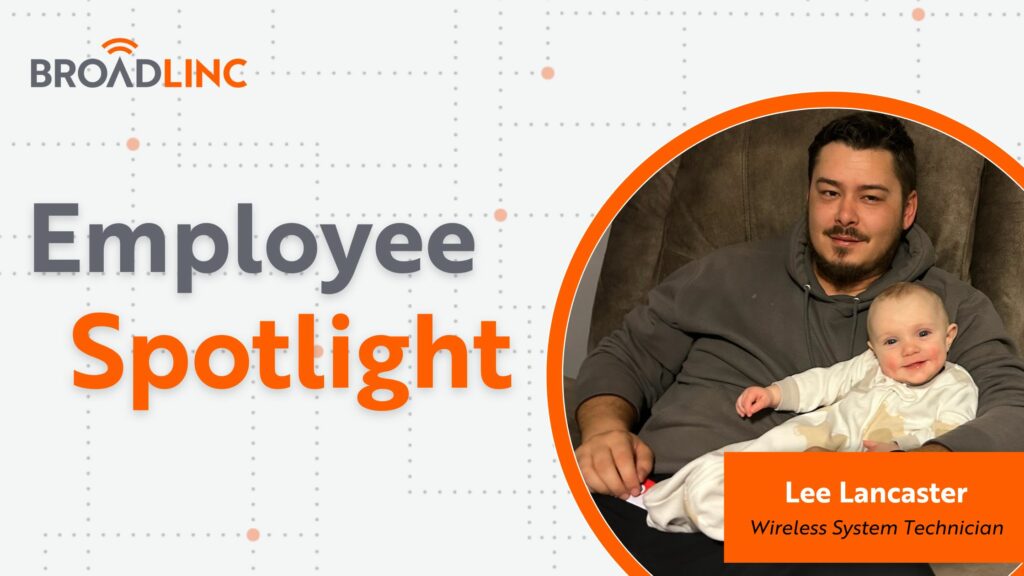
Meet Lee Lancaster
Welcome to February’s edition of our Employee Spotlight series, where we cast a shining light on the stars of our team! This month, we’re super excited to spotlight Lee Lancaster, our exceptionally skilled Wireless System Technician, hailing from our Owenton office. Lee’s workday is a box of chocolates — you never know what you’re going to get. From performing routine maintenance to being the hero who fixes outages, his dynamic role keeps him on his toes and ensures our wireless systems are in top-notch condition. Get ready to dive into the world of Lee, where every day is an adventure in wireless wizardry!
Q & A with Lee
Tell us a little about yourself.
I’m Lee; I have a fiancé and a son (Rikki and Jaxson). I grew up in Owenton and enjoy living in my community.
How long have you been with Broadlinc?
I’ve been with Broadlinc for two years, starting on March 14th.
What brought you to the company?
I wanted change in my work ethic, and Broadlinc was able to provide that change.
What do you like most about being a Wireless System Technician?
I like being outside and enjoying the weather.
What are you most proud of in your career so far?
I’m most proud of all the certifications I’ve received with the company.
What advice would you give to someone that wants to pursue a career in your field?
I advise being ready to be outside, whether it is cold, raining, or even hot.
How would you describe the culture at Broadlinc?
The culture at Broadlinc is family-oriented.
What do you like most about the work we do at Broadlinc?
I like to see customers happy with our internet service.
What do you enjoy doing in your spare time?
I enjoy fishing, playing video games, aggravating my fiancé, and watching my son grow up.
If you could have any superpower, what would it be and why?
If I could have one superpower, I would want to teleport anywhere I wanted.
What’s one thing on your bucket list?
My bucket list goal is to go to Japan.
What piece of advice would you give to your younger self?
Do better; don’t settle for less.

Written By Brittany Derderian, Director of Marketing
Brittany Derderian is the Director of Marketing at Broadlinc internet services. Her responsibilities include leading the company’s marketing efforts, overseeing and growing the marketing department, consistently identifying revenue opportunities within our established client base and managing consistent growth by securing new accounts, collaborating with the leadership team to uncover insights and strategies to develop and implement marketing and branding strategies for new and existing products, and spearheading the strategic and tactical execution of marketing campaigns, including design of test/control segmentation, implementation of tests, tracking, results reporting, analysis, and recommendations. You can find her on the weekends enjoying the outdoors of Colorado with her husband, Logan Derderian.
How Can You Protect Yourself from Internet Hoaxes

How Can You Protect Yourself from Internet Hoaxes
We’ve all see the internet scams that are easy to spot, such as an email from our long-lost relative promising money. All they require is your bank account information, and you’ll see a deposit in two business days!
>Most of us can easily shrug off these somewhat humorous attempts, but not all hoaxes are that easy to spot. Sometimes, we end up falling victim without even realizing we’ve done it. Cyber threats are becoming more sophisticated and piggybacking off of automatic updates, public Wi-Fi networks, and other typical things that are often overlooked. Additionally, they can catch you off guard by coming through trusted sources such as an e-mail from a friend, an update from a celebrity, chain letters, or a site you’ve been to many times.
What is an Internet Hoax?
Internet hoaxes can take a few forms. They’re often meant to spread false information that draws people in. Once the reader clicks on a seemingly innocent link, a virus spreads, stealing sensitive information, clogging your operating system, stalling networks, and slowing down internet and email services.
What is a Common Indicator in Phishing Scams?
The biggest, most blaring indicator of a phishing attempt is an unexpected email or text message with a fake URL, especially if it looks like it’s from a trusted source but is slightly off. The link will often contain malware, spyware, or other computer virus hoaxes. It’s important to be very careful when clicking on attachments in suspicious communications.
Phishing scams are intended to steal personal details such as credit card information. Never give out sensitive information without being absolutely confident of the request’s source. Staying informed about how your companies communicate will help protect you from these fraudulent emails and texts.

Common Types of Internet Hoaxes
When you stay informed about the common ways that internet hoaxes are spread, it’s like another layer of added protection. You can more easily spot suspicious activity when you take simple steps like staying “in the know” and using common sense in misleading situations.
1. Fake news articles
Some websites and articles are designed specifically to trick you into believing false information. Sometimes it’s a part of a political agenda, other times it’s clickbait. This is commonly referred to as “fake news.” Though, it’s not technically illegal to create this kind of content, it is unethical and frustrating to have to sort through.
A website being registered as a nonprofit or a political site doesn’t make it automatically safe. You can search on Google for “fake news sites” and whole lists will come up. All of these sites should be avoided.
2. Viral social media misinformation
Anything has the potential to go viral on social media. There’s not a lot of fact-checking that goes on, and there’s very little restriction about what can be posted. On top of that, people are eager to believe. They want to trust in others, and they want to believe the extremes. It can make some misinformation spread like wildfire. It’s important to do your own research on matters such as these.
3. Email scams and phishing
Email is the most common form of scamming. Hackers will use deception and mimicry to convince you to share your private information.
Phishing, specifically, involves sending targeted emails with links that look like they come from legitimate businesses or other sources. Clicking on whatever link is included usually installs malware on your computer that is tricky or impossible to get rid of. There’s usually something slightly off about these emails, so pay close attention any time you’re considering clicking on a link. Misspelled words, improper capitalization, and unfamiliar logos all indicate something else is going on.
Motivations Behind Creating an Internet Hoax
Spreading fake news may seem pointless, but there are several reasons behind it. One could be that someone is seeking online fame. A catchy, fake story can go viral overnight and the person who shared it might gather millions of followers, likes, and shares from a single video. This is sometimes sought after as a way to boost self-esteem. It doesn’t often create a lasting or loyal following since it almost comes out that the news was fake.
Fake news can also be used to gain money. In fact, some people make a living off of it. Google advertisements pay based on the number of clicks that a website gets. Creating articles full of false, engaging content means people will click on it. Even if the reader soon finds out that it’s fake news, they still clicked, which means the creator gets paid. This is called Clickbait.
What is Online Fraud?
Online fraud is financial fraud and/or identity theft that is committed via the Internet.
Financial fraud is when someone sells fictional goods. They accept payment and personal information, but then they never deliver.
Identity theft is fairly straightforward. It’s when personal information is stolen until another, identical identity can be created. This is useful for a number of illicit reasons and people.
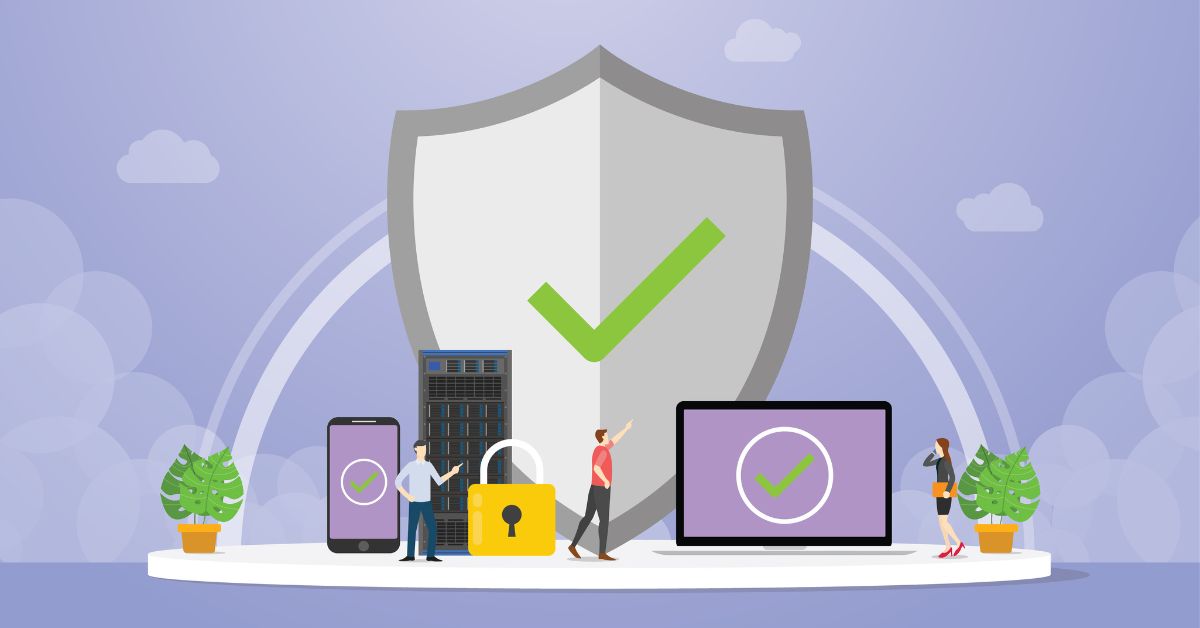
How to Protect Yourself Against Identity Theft
Keep Yourself Safe Online
There are a few things you can do to shore up your online defenses.
Firstly, avoid sharing personal information on social media. Keep any PII (Personally Identifiable Information) to yourself. This includes your Social Security number, bank account information, email address, passport number, driver’s license number, your full name, and anything else that ties directly to you.
Don’t access your personal accounts over unsecured wireless networks. This is one of the fastest ways to lose your information. All public Wi-Fi networks are risky, but ones without passwords are absolutely a risk. Anything you access could be monitored on public Wi-Fi, so be careful.
Use strong and unique passwords. In the cyber world, a strong password can go a long way to protect your accounts. Avoid using the same password across multiple accounts, keep your written passwords out of sight, and avoid common passwords such as your name. If you can manage it, two-factor authentication is a great way to protect your information because it requires twice as much.
Don’t Give Out Personal Information to Unverified Sources
If a phone call or email is asking for personal information, it doesn’t matter how convincing it looks, you should confirm with your company. Find and call a legitimate phone number that isn’t included in the message you received. If they did send out a request, they’ll be able to tell you.
Regularly Review Bills and Account Statements for Unusual Activity
There’s this idea among hackers that small charges won’t be noticed. You can thwart these people simply by keeping close track of your accounts. If you usually get your report in the mail but it doesn’t come, call your company and make sure the mail hasn’t been redirected to another house.
Check Your Credit Report Regularly
You should check your credit at least once a year and make sure that the information displayed is accurate. If you do find strange activity, there are ways you can report it. If the activity does turn out to be fraudulent, you can get it removed from your credit score.
Signs of an Internet Hoax
Signs that what you’re reading is a hoax include:
- Requests to forward the message to as many people as possible. This is so that the false information can be spread far and wide.
- Threats of consequences if you ignore the request. Legitimate companies don’t threaten their customers.
- No/fake source of information. People will often generate their own content to act as sources for their hoaxes.
- No details cited on the author/origin of the information. One of the easiest ways to avoid responsibility for the information you’re sharing is to not exist.
- Clear points in time are never mentioned. The more general information is, the less likely it is to conflict with someone’s prior knowledge.
How to Protect Yourself Against an Internet Hoax
1. Check the Source
Just because it’s online, doesn’t make it true. Be wary of everything you read and check it against your own trusted resources.
2. Fake Videos
Fake videos are nothing new. Since the dawn of YouTube, they’ve been mixing the pot.
Perhaps the easiest way to spot a fake video is to look at the URL. If it has something like “.gif,” “.mp4” or “.wmv,” at the end, it’s probably fake.
3. Fake News Sites
A lot of fake news sites are just meant to spread fear among the populace. If you search up “hoax websites” or “fake news websites” on Google, you’ll find lists of discredited websites that you should avoid.
4. Bitcoin Scams
With cryptocurrencies like Bitcoin rising in popularity, the number of scams involving them has also gone up. Many new sites have been created for the express purpose of fooling people into thinking they’re making a legitimate investment.
Before putting any money down, check out trusted reviews of sites and make sure what you’re looking at isn’t going to end up costing more than you’re looking to spend.
5. Bogus Warnings
Bogus hoaxes are meant to scare people into taking action. There are ones that say milk will give you cancer, and there are others that say eggs will give you a heart attack. The point is to sew fear.
Common sense will protect you from many of these, but if you see something concerning, instead of just swallowing the information whole, look into it further by seeking out real medical sites and studies.
Conclusion
There are plenty of scams out there, but with some strong passwords and good research skills, you can protect yourself from a lot of problems.
Stay aware of what’s going on and the methods by which people spread misinformation, be wary of unusual communications, and always find a way to verify your sources as well as the source of any personal information requests.
Remember, just because it’s from the internet, doesn’t make it true. Stay safe out there.

Written By Brittany Derderian, Director of Marketing
Brittany Derderian is the Director of Marketing at Broadlinc internet services. Her responsibilities include leading the company’s marketing efforts, overseeing and growing the marketing department, consistently identifying revenue opportunities within our established client base and managing consistent growth by securing new accounts, collaborating with the leadership team to uncover insights and strategies to develop and implement marketing and branding strategies for new and existing products, and spearheading the strategic and tactical execution of marketing campaigns, including design of test/control segmentation, implementation of tests, tracking, results reporting, analysis, and recommendations. You can find her on the weekends enjoying the outdoors of Colorado with her husband, Logan Derderian.
How to Disable Alexa Sidewalk

How To Disable Alexa Sidewalk
Please Read if You Have Alexa Echo and Ring Devices on Your Broadlinc Service.
Amazon is enabling many of their devices, such as Echo and Ring cameras, to share the internet service you’re paying for with anyone who wants to use it using a Sidewalk feature. This may be a bad idea for many reasons, especially from a security perspective.
You may not know what this means if you own any of these devices. Let’s go ahead and explain why you want to disable Sidewalk and give you some ways to do that.
Security Risk
First and foremost, security. Sidewalk enables access to your network inside your firewall, bypassing its security features. With this feature enabled, anyone can access your WiFi connection and potentially access your shared files, devices, cameras, or anything else inside your network in your home. Your firewall protection that comes as a default with your router, whether purchased/rented from us or not, protects you from outside threats connecting to your network devices. Once someone has access to the network inside this router’s network, you’re no longer protected from whatever they do.
Slower Connections
Second, you lose control over your internet experience. When someone outside your home is using your internet connection, the signal is being used outside your home, which can slow down your connection due to the signal strength of those devices connected. Also, if these users are using bandwidth, they are using bandwidth your devices need to stream, work, learn, and so on.
In theory, Amazon Echo and other Sidewalk devices use very little bandwidth. However, each device can quickly add up, giving you a noticeable decrease in Internet speed.
Breaks ToS
Third, it’s against our terms of service. As an internet provider, we at Broadlinc believe that good internet shouldn’t come with a laundry list of terms and conditions. However, one rule we take seriously is theft of service.
As a Broadlinc customer, you are not allowed to share your internet connection beyond the address where it is installed. This is to prevent theft of service. We should clarify that service theft is not when you invite a friend or family member to your house and share your WiFi password. One appeal of our services is that multiple people can connect and still have fast internet. By theft of service, we mean when the entire neighborhood has access to your home Wi-Fi network.
Remember, Broadlinc is not a giant corporation; we are a small internet provider to bring affordable and fast internet to rural Kentuckians. Because of this, we want to be able to keep our service affordable and reliable. If the entire neighborhood uses your internet, they aren’t paying for it, and the average usage per customer goes up – which means our rates will have to go up faster than we anticipate. No one likes this, and that includes us. We want to bring affordable internet to your homes, but we must also keep the lights on.
How to Turn Off Amazon Sidewalk Services:
Instructions for the Alexa app:
- Open the Alexa app.
- Open More and tap Settings.
- Tap Account Settings.
- Tap Amazon Sidewalk.
- Turn Amazon Sidewalk Off for your account.
Instructions for the Alexa app:
- Open the Alexa app.
- Go to the Control Center by tapping the three-lined icon in the upper left-hand corner of the screen.
- Select Sidewalk and use the toggle icon to opt-out
- It will ask you to confirm your opt-out.
What Are Sidewalk Bridges?
Before you learn about Sidewalk Bridges, you must know what Amazon Sidewalk is. Amazon Sidewalk is a network that uses little bandwidth or power. The benefit of Amazon Sidewalk is that it can extend the range of your smart home devices. For example, you can put smart home devices on the edge of your yard, where your internet may not reach usually.
Bridges are participating in Amazon Sidewalk devices. These compatible devices use a little bit of their bandwidth to help create the Amazon Sidewalk network. Amazon Sidewalk devices can. Could you send information up to a half-mile away?
With Amazon Sidewalk, you can receive local notifications. If you’re going on a neighborhood walk, you can keep track of your Ring app or see your Ring spotlight cam mount send you info in real time.
While there are benefits, many want to opt out of Amazon Sidewalk-enabled devices. You may be concerned about privacy concerns or sharing your internet bandwidth with others.
Who To Contact If You Cannot Disable Sidewalk
It’s simple to disable Sidewalk on Amazon devices like Alexa and Ring apps, but sometimes it doesn’t work. Where can you go from here if you cannot disable Amazon Sidewalk? There are a few options:
Contact Broadlinc Customer Service
If your Echo smart speakers, Ring floodlight cam, or other Echo devices have difficulties turning off Sidewalk, please contact us. Our customer support team can help you disable Sidewalk and look into any issues you may have. We understand that most people with Echo and Ring devices do not want to participate in the theft of service, so do not be afraid to contact them.
Don’t feel like sitting on the phone? Then could you email us? Our customer support team’s email is support@wcloudus.com. When you email us, a representative should email you back as soon as possible.
Amazon Customer Service
You can also go to Amazon. Amazon’s customer service has several avenues you can take. You can visit their community pages with general answers to commonly asked questions. These answers include basic tutorials about Amazon’s Sidewalk network. Please feel free to request a call and speak to a representative. In addition, Amazon has a support chat that is usually available all week to help you.
Turn Off the Devices
If you’re in the process of disabling Sidewalk, keep the devices turned off for the time being. This will prevent anyone from connecting to your network.
Final Thoughts
While Sidewalk is a good idea, it may pose a security risk, lower your speeds, and possibly lead to a termination of your account. To play it safe, be sure it’s disabled when you use any Amazon devices.
Employee Spotlight: Noven Harris
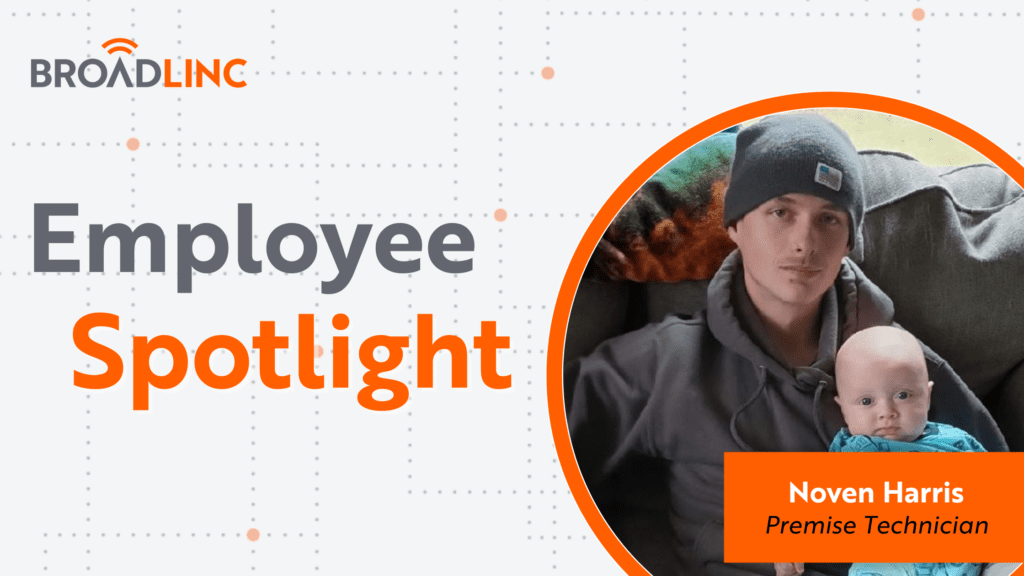
Meet Noven Harris
Welcome to our Employee Spotlight series for January! We’re excited to shine a light on Noven Harris, our dynamic Premise Technician who keeps things running smoothly from our Owenton office. With a knack for tackling service calls and a wizard at regular maintenance for cable internet in Owen County, Noven is the go-to expert for new installations. He’s not just about cables and connections; his role extends to being the friendly face that answers all customer queries before they’re officially connected. Get ready to meet the man who’s always plugged into improving our customer experiences!
Q & A with Noven
Tell us a little about yourself.
I’m an Owen County kid, born and raised. I have a fiance and a 4-month-old son. I have three dogs, five cats, three fish, and two chickens. We recently just bought our first home. We’ve just been trying to live our best life.
How long have you been with Broadlinc?
I’ve been with Broadlinc for two years now.
What brought you to the company?
I have a family member who works for Broadlinc, and I live in the area, so it started from there.
What do you like most about being a Premise Technician?
What I like about being a Premise Technician is how it’s different every day. Some days are the same, but mostly, you get to see many places and meet many people daily.
What are you most proud of in your career so far?
I started my career unable to mess with computers or laptops, and now I have learned how to program and install wireless antennas. I’ve also had great success on the cable side dealing with climbing telephone poles and installing TV services and cable internet.
What advice would you give to someone that wants to pursue a career in your field?
I would advise going for it; it’s a great opportunity to help connect your community to get the fastest, most reliable internet out there.
How would you describe the culture at Broadlinc?
The culture at Broadlinc is like a small family. Everybody gets along and helps each other when needed.
What do you like most about the work we do at Broadlinc?
I love it when somebody who usually can’t get internet in the middle of nowhere can call us and get hooked up, and we can connect them to the rest of the world.
What do you enjoy doing in your spare time?
I enjoy hanging out with my family, fiancè, son, and animals. I also enjoy hunting and fishing. I also enjoy shooting firearms.
If you could have any superpower, what would it be and why?
If I could have one superpower, I’d want to be able to see three days into the future so that I always know what to expect and how to handle it.
What’s one thing on your bucket list?
My bucket list goal is to have a piece of land where I can be self-sufficient and not have to deal with everyday society.
What piece of advice would you give to your younger self?
Don’t lose faith; keep on going, and everything will always work out how it needs to.

Written By Brittany Derderian, Director of Marketing
Brittany Derderian is the Director of Marketing at Broadlinc internet services. Her responsibilities include leading the company’s marketing efforts, overseeing and growing the marketing department, consistently identifying revenue opportunities within our established client base and managing consistent growth by securing new accounts, collaborating with the leadership team to uncover insights and strategies to develop and implement marketing and branding strategies for new and existing products, and spearheading the strategic and tactical execution of marketing campaigns, including design of test/control segmentation, implementation of tests, tracking, results reporting, analysis, and recommendations. You can find her on the weekends enjoying the outdoors of Colorado with her husband, Logan Derderian.
Employee Spotlight: Nathan Mitchell

Meet Nathan Mitchell
Welcome to the latest edition of our Employee Spotlight series, where we celebrate the outstanding talents within our team. This month, we’re excited to shine a light on Nathan Mitchell, our remarkable Premise Technician from Whitesville, KY.
Nathan is the epitome of dedication and expertise, brilliantly handling everything from installing wireless and cable internet to ensuring complete customer satisfaction. He’s not just a tech wizard; Nathan often steps in to assist his colleagues with various tasks and line work. Dive into this feature to discover more about Nathan’s impactful journey with Broadlinc!
Q & A with Nathan
Tell us a little about yourself.
My name is Nathan Mitchell; I’m from Whitesville, KY. I have been here my whole life and have a wife and three kids.
How long have you been with Broadlinc?
I have been with Broadlinc since May 8, 2023.
What brought you to the company?
What brought me to this company is how they make you feel like family. And the chance to have a career instead of contract work, which I have done in the past.
What do you like most about being a Premise Technician?
I like meeting customers, growing relations, and creating friendships with people I have never met the most.
What are you most proud of in your career so far?
I’m most proud of my job now. Nothing is certain besides having a career that can open many future opportunities within one company.
What advice would you give to someone that wants to pursue a career in your field?
I advise someone wanting to enter this field to go for it. You don’t need schooling. It’s a career that can last until retirement, and you can learn all you need while on the job.
How would you describe the culture at Broadlinc?
To me, the culture at Broadlinc is just one big family. Everyone treats you as a friend; you are not just another employee or number in the company.
What do you like most about the work we do at Broadlinc?
I like that Broadlinc offers reliable services in rural areas. I like how we are reaching customers without service and significantly impacting them.
What do you enjoy doing in your spare time?
My spare time is spent with my wife and kids or in the shop with a friend doing woodworking on the side.
If you could have any superpower, what would it be and why?
If I had to pick a superpower, I’d have to go with the ability to fly because it would be fun.
What’s one thing on your bucket list?
The number one thing on my bucket list is owning a few dream cars and having the experience of sharing those vehicles with my kids.
What piece of advice would you give to your younger self?
A piece of advice to my younger self: work hard and stay committed. That’s the best way to become what you want to be.

Written By Brittany Derderian, Director of Marketing
Brittany Derderian is the Director of Marketing at Broadlinc internet services. Her responsibilities include leading the company’s marketing efforts, overseeing and growing the marketing department, consistently identifying revenue opportunities within our established client base and managing consistent growth by securing new accounts, collaborating with the leadership team to uncover insights and strategies to develop and implement marketing and branding strategies for new and existing products, and spearheading the strategic and tactical execution of marketing campaigns, including design of test/control segmentation, implementation of tests, tracking, results reporting, analysis, and recommendations. You can find her on the weekends enjoying the outdoors of Colorado with her husband, Logan Derderian.
Finding Internet Availability In Rural Kentucky

Finding Internet Service In Rural Kentucky
Finding Kentucky Internet service providers is much more challenging if you live in a rural area. The low population means many Kentucky Internet providers will focus on urbanized areas. Another challenge is the infrastructure. For example, fiber Internet requires cables that may be impractical or too expensive to implement. However, as the Internet is a necessity for modern life, there have been moves to bring high-speed Internet to rural areas, including Kentucky.
What Reasons Would I Need Rural Internet Service?
Finding broadband Internet service for rural areas is becoming increasingly important. Here are some reasons why you need rural Internet providers in Kentucky.
1. Everyday Needs (Entertainment, Socializing)
High-speed Internet has become important if you want to enjoy everything the Web offers. Broadband Internet providers can help you with:
Working from Home
Rural living is beautiful, peaceful, and affordable. However, one downside is a lack of well-paying job opportunities. Often, many residents have to commute long distances to find a job, with travel being expensive and time-consuming.
However, work-from-home jobs have become more popular. These jobs can pay well, and as long as you have a fast connection, you don’t need to leave your home. Having an online job means it’s possible to make a great living without moving to a costly city.
However, most work-from-home jobs require fast Internet speed. It would be best to have fast upload and download speeds to make video calls, upload large files, and stay connected. Generally 15-25 Mbps is the minimum needed for a good work from home experience.
We also include small businesses in this. A fast connection can make online sales much easier if you own a small business.
Streaming & Entertainment
Today’s entertainment usually goes up to 4K. A fast Internet service provider means you can watch your favorite shows in crystal-clear 4K without buffering. Streaming can also include live streaming from your home. For example, some people record themselves playing video games or doing their favorite hobby. A fast connection means you can live stream in full HD without lag.
Another reason you may want a fast connection is if you play video games. If you play online multiplayer titles, you need a fast connection or suffer a lag. But even if you play single-player titles, we’re entering a digital-only age. With game file sizes getting more prominent, rural Internet speeds mean it may take all day, or multiple days, to download a game you’re interested in. On the other hand, broadband speeds mean you can download a game in minutes.
Socializing
Social media does not need too much bandwidth if you want to send texts. But today, many people socialize with more demanding methods than email only. People love to video chat, send large photos, or voice call. Rural Internet speeds can mean taking forever to show a nice picture you took or a spotty voice chat. Fast wireless Internet providers can help you socialize without worry.
2. Outliers/Off-grid people
If you live off-grid or in an RV, you can still get fast Internet access. One option is to see if there are any satellite Internet providers in your area. You can get Internet access if your home has a receiver. Another option is to see if there are any fixed wireless providers. As long as you have a receiver and are near a tower, you can have high-speed Internet.
Besides living off-grid, some areas in Kentucky make it extremely difficult to build Internet infrastructure. If you live deep in Appalachia, you may not have access to even DSL. When wired Internet is nearly impossible, wireless options can keep you connected.
3. Security or Communication
Rural police may benefit from having high-speed Internet to make communication faster. Meanwhile, if you own a farm, you may want a security system. Many smart cameras, sensors, and other security devices have Wi-Fi connections. For example, you can purchase Wi-Fi cameras that show live video from your mobile devices. Having fast Internet speed means these devices can run as smoothly as possible.
These are several reasons why you need fast speeds. The modern Internet is exchanging large files all the time, something that rural Internet providers have failed to keep up with for far too long.

What Internet Options Are Available to Those Living in a Rural Area?
You may find several types of Internet providers when you live in a rural area. Here are some of the options you may have.
Fiber Optic
Fiber optic Internet uses fiber optic cables. These cables transmit data through pulses of light. Because of this method, you can have download and upload speeds that exceed a gigabyte per second. For many, fiber Internet is the number one choice.
However, fiber optic can be expensive and may be more than you need. Not only that, but most rural areas do not have it yet. Thanks to government efforts, this is slowly changing, but fiber is still only available in around half the state.
Cable Internet
Cable internet is a high-speed broadband connection that uses the cable television coaxial cables to deliver internet access. Cable internet offers faster speeds compared to DSL and is widely available in urban and suburban areas.
If you live near rural cities in Kentucky, cable internet may be an option for high speed internet access.
4G Mobile Broadband
This Internet service uses a cellular tower that sends a connection to a receiver. Alternatively, you may use your phone as a 4G hotspot if you have an unlimited data plan. The benefit of 4G Internet is that it is affordable but can be inconsistent. If you’ve driven around rural Kentucky, you probably know there are dead zones and areas with low signal. Another downside of 4G is that it’s only suitable for light Internet use. You may have difficulties downloading or uploading large files.
There is 5G broadband, which is a lot faster. However, most rural areas have yet to receive access to 5G.
DSL
Digital subscriber line (DSL) has been one of the main ways rural residents connect to the Web. DSL uses phone lines, which exist in most rural areas. It’s also cheap. However, DSL speeds only reach a few megabytes for many people. While some DSL providers can reach speeds up to 100 Mbps, this is rare. Your average DSL Internet provider won’t give you enough to stream 4K movies or work from home.
Satellite Internet
Satellite Internet uses a satellite dish from space and a receiver at your home. Satellite can have fast max download speeds that exceed 100 Mbps, but it depends on the provider you choose and several other factors.Most Satellite providers have a cap, where you are throttled at a much lower speed once that threshold is capped, which will make streaming impossible. Also satellite has higher latency, which can prevent realtime communications such as web conferencing and gaming. Stormy weather may lead to you having slower connections due to how far the satellite dish is from the receiver.
Fixed Wireless Internet
Fixed wireless internet has emerged as a game-changing technology for rural areas, providing a reliable and high-speed internet connection in regions where traditional broadband infrastructure is often lacking or non-existent. Leveraging wireless transmission towers to send and receive internet signals, this innovative solution bypasses the need for expensive and labor-intensive cable installations. Residents in remote locations can now access internet speeds comparable to their urban counterparts, unlocking a world of opportunities in terms of education, business, healthcare, and entertainment. The technology is particularly advantageous due to its rapid deployment capabilities and cost-effectiveness, addressing the digital divide and fostering greater connectivity and economic growth in rural communities. As fixed wireless internet continues to evolve and expand its coverage, it is poised to play a crucial role in bridging the digital gap and ensuring that rural areas are not left behind in the digital age.
A Kentucky Internet provider that offers fixed wireless can bring you fast speeds. However, your house must be within a 10-mile radius of the tower without obstructions to get the most out of it.

Why Broadlinc Stands Out from Satellite Internet Providers
Finding fast Internet services in rural Kentucky is like finding fish in a dried-up pond. For a long time, most of rural Kentucky has been ignored, with most rural Internet providers in Kentucky offering the bare minimum. One reason for this is that most of these are corporations run by people who have never lived in Kentucky.
Like you, we grew tired of the growing digital divide between rural and urbanized areas and decided to take matters into our own hands. We’re Broadlinc, a rural Internet service provider bringing broadband speeds to rural residents. We were founded in rural Kentucky by rural Kentuckians. We’re here for you if you want fast speeds, unlimited data, and a service that cares about its customers.
Get Faster Internet Access with Broadlinc
Our fixed wireless can offer up to 50mbps and our cable Internet can give you max download speeds of up to 200mbps. Each day, we’re serving more and more Kentucky residents as we expand our services across the state. If you’re in our area, then we can help.
Please compare Internet providers in your area to ensure we’re giving you the best experience. See if Broadlinc can give you speeds much faster than the competition. We also offer custom packages if you run a business.
How to Check for Internet Availability in Rural Kentucky?
We make it easy for you to see if we’re serving your area. Enter your address and other information. We’ll be sure to let you know if we have broadband connectivity options in your area or if we have plans to.
Conclusion
Fast Internet is more needed than ever in rural Kentucky. With DSL connections and satellite, streaming 4K media, working from home, or downloading large files in a reasonable time is nearly impossible. Luckily, many options are becoming available.
The best options for fast speeds are fiber and fixed wireless. At Broadlinc, we provide fast fixed wireless connections with download speeds that allow you to enjoy the Internet’s modern conveniences. We also offer TV, phone, and customized packages.
Please get in touch with us today to see what we offer in your area. We’d love to hear from you and meet your needs.

Written By Brittany Derderian, Director of Marketing
Brittany Derderian is the Director of Marketing at Broadlinc internet services. Her responsibilities include leading the company’s marketing efforts, overseeing and growing the marketing department, consistently identifying revenue opportunities within our established client base and managing consistent growth by securing new accounts, collaborating with the leadership team to uncover insights and strategies to develop and implement marketing and branding strategies for new and existing products, and spearheading the strategic and tactical execution of marketing campaigns, including design of test/control segmentation, implementation of tests, tracking, results reporting, analysis, and recommendations. You can find her on the weekends enjoying the outdoors of Colorado with her husband, Logan Derderian.
Employee Spotlight: Ben Young

Meet Ben Young
Welcome to the latest edition of our Employee Spotlight series, where we celebrate the outstanding talents within our team. This November, we’re absolutely thrilled to introduce you to the exceptional Ben Young, our dedicated Premise Technician stationed at our Owenton office.
Ben’s role is a dynamic mix of technical prowess and customer satisfaction. From installing wireless and cable internet to completing service calls, he ensures that every customer’s experience ends with a smile.
Join us as we delve into Ben’s journey at Broadlinc, exploring his skills, his dedication, and the impressive contributions he brings to our team!
Q & A with Ben
Tell us a little about yourself.
I grew up in Poplar Grove, outside of Owenton. I have been married to my wife Mandy for 25 years, and we have three children (Amber, Shelby & Dristen) and seven grandchildren (Lincoln, Jackson, Maisyn, Haislee, Palmer, Kennedy, & Collins).
How long have you been with Broadlinc?
I have worked for Broadlinc since September 2021.
What brought you to the company?
My son-in-law, Matt, who also works for Broadlinc, introduced me to the company and encouraged me to apply as a Premise Technician.
What do you like most about being a Premise Technician?
I love the flexibility of working with each customer and effectively completing each order or service call one-on-one. I like that every day is different.
What are you most proud of in your career so far?
I am most proud of my ability to learn and grow as an internet technician. I am not a tech-savvy person, but with good leadership, I’ve been able to learn so much and help our customers.
What advice would you give to someone that wants to pursue a career in your field?
My advice would be to be a people person.
How would you describe the culture at Broadlinc?
The culture at Broadlinc is just like a family. We are all friends and work together well. We all help each other.
What do you like most about the work we do at Broadlinc?
I love that we give customers a better option for internet service than they usually have.
What do you enjoy doing in your spare time?
I enjoy being at home with my family. I like to hunt and fish when I have time.
If you could have any superpower, what would it be and why?
I want to be able to fly like an eagle. It would be cool to feel that freedom.
What’s one thing on your bucket list?
One thing I would like to do on my bucket list is to take a train ride through Switzerland in the winter.
What piece of advice would you give to your younger self?
My advice would be to take more chances.

Written By Brittany Derderian, Director of Marketing
Brittany Derderian is the Director of Marketing at Broadlinc internet services. Her responsibilities include leading the company’s marketing efforts, overseeing and growing the marketing department, consistently identifying revenue opportunities within our established client base and managing consistent growth by securing new accounts, collaborating with the leadership team to uncover insights and strategies to develop and implement marketing and branding strategies for new and existing products, and spearheading the strategic and tactical execution of marketing campaigns, including design of test/control segmentation, implementation of tests, tracking, results reporting, analysis, and recommendations. You can find her on the weekends enjoying the outdoors of Colorado with her husband, Logan Derderian.
Employee Spotlight: Kelly Vincent

Meet Kelly Vincent
Step right into the latest installment of our Employee Spotlight series, where we showcase the brightest talents within our team. This month, we are absolutely delighted to introduce you to none other than Kelly Vincent, our stellar Sales Representative stationed at our Bremen office.
Kelly’s role is a unique blend of building connections, friendships, and trust within our community. Her enthusiasm and dedication are truly contagious. Join us as we dive deeper into Kelly’s journey at Broadlinc and discover what makes her shine in the world of sales!
Q & A with Kelly
Tell us a little about yourself.
Bremen, KY is where I was born and raised. My life has been blessed for nine years with my loving husband, Dennis, and our two incredible daughters, Alivia, who’s 14, and Ady, who’s 11.
How long have you been with Broadlinc?
I have worked for Broadlinc for one and a half years.
What brought you to the company?
My quest for a job led me to Broadlinc. The position caught my eye, as it seemed both intriguing and conveniently close to home.
What do you like most about being a Sales Representative?
Connecting with people in the community is what I cherish most about being a Sales Representative.
What advice would you give to someone that wants to pursue a career in your field?
A career in sales is profoundly rewarding. It’s an opportunity to forge daily connections with new people and build trust within the community.
How would you describe the culture at Broadlinc?
It’s a very laid-back environment and low-stress for the most part.
What do you like most about the work we do at Broadlinc?
I like being able to provide people with the essential services to those in need.
What do you enjoy doing in your spare time?
My spare moments are often occupied by race tracks, ball fields, or piano recitals. My kids keep me busy!
If you could have any superpower, what would it be and why?
Teleportation would be my superpower of choice, allowing me to travel instantly from one place to another.
What’s one thing on your bucket list?
The number 1 thing on my bucket list is traveling to New Zealand, which will likely happen next November.
What piece of advice would you give to your younger self?
My advice would be to not worry about the small things and to follow your heart.

Written By Brittany Derderian, Director of Marketing
Brittany Derderian is the Director of Marketing at Broadlinc internet services. Her responsibilities include leading the company’s marketing efforts, overseeing and growing the marketing department, consistently identifying revenue opportunities within our established client base and managing consistent growth by securing new accounts, collaborating with the leadership team to uncover insights and strategies to develop and implement marketing and branding strategies for new and existing products, and spearheading the strategic and tactical execution of marketing campaigns, including design of test/control segmentation, implementation of tests, tracking, results reporting, analysis, and recommendations. You can find her on the weekends enjoying the outdoors of Colorado with her husband, Logan Derderian.
Employee Spotlight: Laura Perkins

Meet Laura Perkins
Step into the limelight with us as we unveil the newest star of our Employee Spotlight series for September! Prepare to be captivated by the remarkable journey of Laura Perkins, our exceptional Service Assurance Coordinator stationed in our Owenton office. With her unwavering dedication, Laura orchestrates seamless collaborations across departments to tackle customer concerns, ensuring that your needs are met promptly, whether it’s installing our services or resolving any issues that may arise. Laura’s mission? To swiftly usher you into the capable hands of our tech experts.
Q & A with Laura
Tell us a little about yourself.
I come from a long line of Owen County farmers. My family has been in this community for several generations. I plan to stay in this community and hopefully have a farm.
How long have you been with Broadlinc?
I’ve been with Broadlinc for a little over a year.
What brought you to the company?
I was looking for something more career-oriented to improve my work/life balance. Broadlinc offered that and continues to provide growth opportunities. Personally and professionally.
What do you like most about being a Service Assurance Coordinator?
I love that not every day is the same, and I face different challenges.
What are you most proud of in your career so far?
I’m proud of the current scheduling process that we have been able to create here.
What advice would you give to someone that wants to pursue a career in your field?
My best advice is to be patient and learn to think on your feet.
How would you describe the culture at Broadlinc?
We have a very collaborative and friendly work culture.
What do you like most about the work we do at Broadlinc?
I like that we improve people’s quality of life by providing a service many otherwise wouldn’t have access to. I also love that Broadlinc gets involved with the surrounding communities by attending events or providing a free public service.
What do you enjoy doing in your spare time?
I have too many hobbies. I’ve mostly been doing home renovations. I enjoy just about everything. Gaming, carpentry, hiking, and I love the process of building or creating, from working with clay and epoxy and putting together model spaceships to building structures.
If you could have any superpower, what would it be and why?
My superpower would be super strength, hands down. You can run fast, lift, climb, and jump over anything.
What’s one thing on your bucket list?
Hiking Mt. Fuji.
What piece of advice would you give to your younger self?
Be patient and take it easy on yourself. Rome wasn’t built in a day.

Written By Brittany Derderian, Director of Marketing
Brittany Derderian is the Director of Marketing at Broadlinc internet services. Her responsibilities include leading the company’s marketing efforts, overseeing and growing the marketing department, consistently identifying revenue opportunities within our established client base and managing consistent growth by securing new accounts, collaborating with the leadership team to uncover insights and strategies to develop and implement marketing and branding strategies for new and existing products, and spearheading the strategic and tactical execution of marketing campaigns, including design of test/control segmentation, implementation of tests, tracking, results reporting, analysis, and recommendations. You can find her on the weekends enjoying the outdoors of Colorado with her husband, Logan Derderian.
The Best Mesh WiFi Router For Thick Walls

The Best Mesh WiFi Router For Thick Walls
You want a strong Wi-Fi signal throughout your home, but living in a multi-bedroom or multi-floor home can be challenging. One solution you can try is a mesh Wi-Fi system. A mesh system can help improve your Wi-Fi, and a mesh network might be your answer. Read on to know what mesh systems are and if a mesh Wi-Fi router is for you.
Here at Broadlinc, we offer a mesh WiFi system for our customers to improve the internet connection throughout their house. After decades of working in this industry, we’ve learned that often the speed to the house is fine, but drops off dramatically as one moves away from the router.
This internet quality degradation can be especially bad in rural farm houses with their heavy, plaster and lathe walls. These same walls that stopped cannonballs in the civil war are equally good at slowing internet speed.
Which is why mesh WiFi is such a game changer for folks with large house, older, well-built houses, and houses with thick walls.
What is a Mesh Wi-Fi System?
A mesh Wi-Fi system uses several nodes connected to a single wireless network, which helps bring a consistent Wi-Fi system to your home. A traditional Wi-Fi system only has one router, which may work for smaller homes, but if you have a larger home or obstructions, there can be rooms in your home where your network has little, if any, signal strength. To keep your home or your business consistent, we recommend mesh routers.
With a great mesh Wi-Fi system, you can have consistent Wi-Fi signals in areas you normally wouldn’t be able to. In addition, mesh nodes can come equipped with extra features, such as security software or an app similar to Plume Homepass that allows you to control who uses your Wi-Fi.
Where Do I Put Mesh Systems?
Before placing your mesh systems, you should know where the dead zones in your home are and if you want Wi-Fi coverage in areas outside the home. A mesh system node will tell you how many square meters it will cover, giving you a rough idea of where to put your mesh system.
Ideally, your mesh Wi-Fi system should begin near your router, and placing one or two on each floor is ideal, preferably in the middle, for consistent Wi-Fi coverage. If you wish to have a mesh Wi-Fi system in outdoor areas such as your porch or garden, putting a mesh system node near the closest window may help. Ultimately, your mesh Wi-Fi system setup can depend on your home’s unique needs.
Why Mesh Systems Struggle With Thick Walls (And How To Overcome It)
In the classic mesh network, each new pod, talks to the next one, helping your signal “leapfrog” through the house. However, thick walls make it difficult for this signal to get through. Often this means that you need an excessive number of pods for your mesh network, and even then — if your walls are thick enough — it might not work very well.
What can be a better option is to run ethernet from pod to pod. By connecting each pod with a hardwire ethernet cord, you can bypass the problem posed by thick walls and help the signal reach all corners of the house by creating miniature WiFi hotspots. However, there is a downside to doing this. In this setup, each “pod” generally has its own separate SSID, which means that you have to log into the correct one, depending on which room you are in. For those of us who use our phones for WiFi calling, we know just how frustrating it is to drop a call because you walked out of the living room.
The best option for thick walls, then, is a mesh/hardwire hybrid that combines the best of both options. With Plume Homepass, the individual pods can be wired together using ethernet, creating multiple WiFi access points throughout the home. Unlike other access points which require separate WiFi SSIDs to switch between, Plume Homepass keeps it all as one. This allows you to easily walk through the house with no interruptions of internet service.
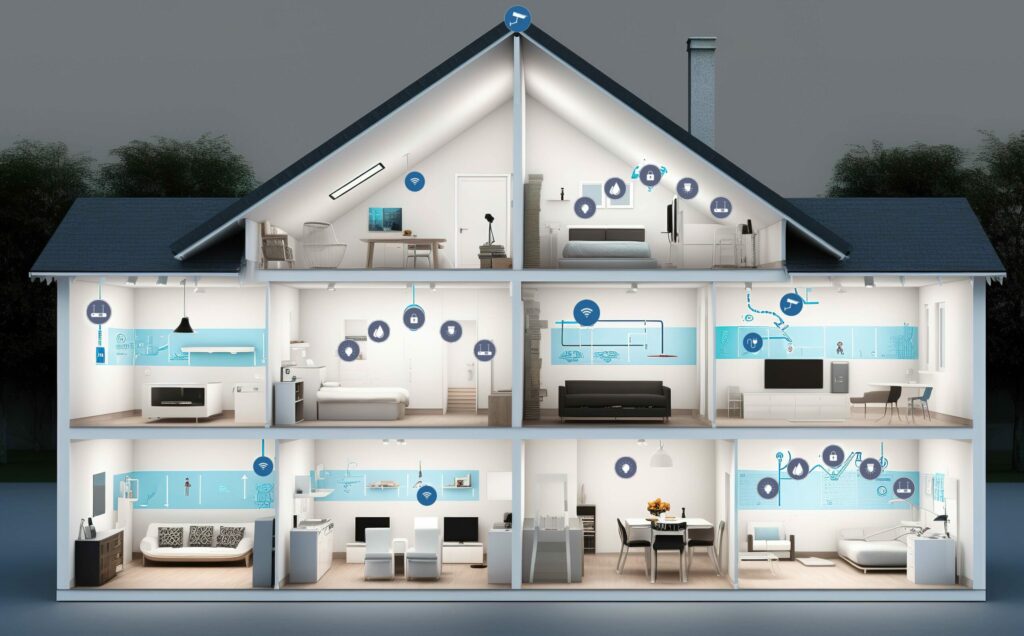
Can Mesh Wi-Fi Systems Improve Speed?
While a mesh Wi-Fi system cannot improve your ISP’s maximum speeds, what it can do is increase speeds in areas where you don’t have maximum Wi-Fi coverage. For example, if you have a man cave where you play gaming consoles and have other devices, mesh systems for thick walls can ensure you can download digital games and updates without taking hours, and play online games without lag. You can stream 4K content from smart TVs in rooms that normally have trouble through these mesh nodes.
This is also good for security software, providing consistent connection between your security system and the internet.
Mesh Wi-Fi Network vs Wi-Fi Extender?
A Wi-Fi network and extender will give you more Wi-Fi coverage, but a Wi-Fi mesh system uses the same Wi-Fi network. Meanwhile, a Wi-Fi extender will have a different network, which can be a hassle if you travel throughout your building and your device constantly switches. While it is possible to have Wi-Fi extenders on the same page, a mesh Wi-Fi network makes it so you don’t have to jump through hoops to make everything consistent.
Things to Consider When Buying the Best Mesh System
When shopping for mesh Wi-Fi routers, here are some major considerations you should make for your mesh Wi-Fi system. Most mesh Wi-Fi systems will have some of the below, which can help you get the most out of your mesh network.
Coverage
Three Wi-Fi nodes should cover around 2,000 square feet. Of course, how much Wi-Fi coverage you need can depend on your home size. It should be easy to look at the mesh capability on the box and compare it to your house size.
Number of Units
How many are needed for your home, and how many does the Wi-Fi node package contain? Most Wi-Fi node packages will contain two or three mesh system nodes. Usually, three is good enough for most houses, but there may be cases where you need even more Wi-Fi coverage. Luckily, it is easy to buy more Wi-Fi nodes, if you need them.
Speed
How much speed can the Wi-Fi nodes support? Most will support around 3Gbps, but some go beyond. For most people, Wi-Fi that carries 3Gbps is enough, but there may be cases where you may need more, such as if you live in a house where multiple people are downloading large files all at once.
Dual or Tri-band
Your Wi-Fi network likely supports 2.4 or 5 GHz networks, but some will support two 5 GHz, which is good for shorter distances. In short, a 2.4 GHz Wi-Fi network has further distances but slower speeds. 5 GHz Wi-Fi means you get faster speeds but shorter distances. Because a mesh Wi-Fi system can extend your coverage by quite a bit, you should go for 5 GHz, typically.
Wi-Fi 6 support
A Wi-Fi 6 mesh node will future-proof your home, as Wi-Fi 6 is currently the fastest standard. If you choose below Wi-Fi 6, it may become dated, giving you speeds that don’t cut it in a few years as the file sizes increase. If a node has Wi-Fi 6 mesh support, grab it!
Wi-Fi 6E support
You’ve heard of a Wi-Fi 6 mesh system, but what about Wi-Fi 6e? This gives you a 6 GHz network, but it’s expensive, and few devices support it. However, it can help to future-proof your home over a Wi-Fi 6 mesh network. Because while most of your other devices won’t be able to support it, they may be able to in only a few years. Technology moves at a quick pace, so be ahead of the curve. One example of a router with 6E is Google Nest WiFi. Some, such as the TP Link Deco, go even beyond that. For example, some TP Link Deco units have Wi-Fi 7.
Subscriptions
Some Wi-Fi nodes will charge a subscription fee or bundle more services. For example, some mesh Wi-Fi systems charge extra if you want features such as parental controls, home protection, and more. Some people will be glad to spend a little extra, while others will just want the mesh Wi-Fi system without the extra money. Be sure you’re not spending more than you need! With Broadlinc’s Whole Home Wifi, the cost of the subscription is included with the rental of the nodes.
Parental controls
Have kids? Some Wi-Fi nodes let you control how much Wi-Fi your kids use and what they see. One reason your mesh Wi-Fi system may need parental controls is when your child spends too much time online and not enough time on their schoolwork. Not only can you get a strong Wi-Fi connection, but you’re in control of what your kids do with it.
Voice integration
You can turn on a fast Wi-Fi 6 network with your voice, which is convenient. In today’s world of smart homes, controlling your Internet connection with your voice is a luxury that you want, especially if you need to turn on or off a guest network.
Mobile App Management
Some Wi-Fi 6 nodes let you control them through an app. Once again, this feature is found in many modern smart homes, and with it, you can let multiple devices easily access your Wi-Fi network or restrict access to certain people.
Design
Some Wi-Fi 6 nodes look sleeker and less intrusive than others. In many homes, the best mesh Wi-Fi router is barely seen. Some may look bulkier, which can take up space and stick out when showing people your house. Of course, some people don’t care how their mesh system looks and care more about the mesh routers’ power. Luckily, many mesh Wi-Fi systems have both looks and power across all connected devices.
Is a Mesh Router Better Than a Normal Router?
If you have a larger home, a mesh Wi-Fi 6 system can be necessary, but not if you live in a smaller apartment, where you can easily use gigabit ethernet ports to speed up your Internet.

Benefits of Mesh Wi-Fi
These have many benefits, including:
Improved Coverage
A Wi-Fi 6 mesh system will have a consistent signal throughout a large home. Without it, your Internet signal may be inconsistent in certain areas, making it difficult to surf the web or download large files. With these nodes, you can have maximum coverage throughout the entire home.
Eliminating Dead Zones
Sometimes, your home can have Wi-Fi dead zones. For example, if you have only one main router, you may not have any connection in the basement or the furthest room from it. However, with a Wi-Fi 6e mesh setup, you can connect devices across your entire home. No having to go to another room to get a signal with a Wi-Fi 6 mesh system.
Mobile App
Many Wi-Fi 6 nodes let you control them through an app, making managing it simple. The app is usually integrated with other features, such as advanced parental controls. You don’t need to go across your home to see what your kids are doing, and you can let your guests easily access your Internet speed.
Simple Configuration
The setup process for your Wi-Fi 6 mesh system is easy. Quite often, it only involves following some simple instructions on the packaging, and the most complicated thing is to figure out where your nodes need to be placed. If you have any trouble with your mesh Wi-Fi systems, most have stellar customer support as well. This way, your mesh system can be set up without having to deal with
High Link Speeds
Wi-Fi 6 nodes can support fiber speeds! One misconception about Wi-Fi is that it’s slow, but with these nodes, you can support speeds up there with four gigabit Ethernet ports. Your device doesn’t need two Ethernet ports to go fast; a great mesh system will give it speeds that let you download large files in seconds and stream 4K content without any buffering.
Disadvantages of a Mesh Router
Some nodes, especially a Wi-Fi 6 router, can be much more expensive than a traditional router. Because of this, you want to ensure that your existing router does the trick. Usually, you won’t need these unless you live in a bigger home; for most apartments, a regular router should work unless you have concrete walls.
Besides that, there aren’t too many disadvantages to mesh systems. They do what they promise; to extend your Wi-Fi network as most as possible throughout your home. While some mesh systems work better than others, your typical mesh system should give you great coverage throughout.
Make the most out of your Mesh Network System
If you want the best Wi-Fi coverage, there’s only one rule:
Placement of the Router and Nodes
Be sure to place your nodes in the right places for the strongest Wi-Fi signals. Once again, each home WiFi system will have a different node setup, as each place is different. One way to ensure that a mesh Wi-Fi system has the best coverage is to put mesh routers in areas that normally don’t have good signals.
Frequently Asked Questions
Does Mesh Wi-Fi Go Through Walls?
Mesh Wi-Fi can penetrate walls due to its strength, but the Wi-Fi power can depend on the walls’ thickness. Usually, the modern mesh Wi-Fi system can work for most walls, but not all are created equally.
Do Thick Walls Affect WiFi?
Thick walls, furniture, and other objects can affect Wi-Fi strength. A mesh Wi-Fi system can give you great coverage in areas where the walls are thick. Purchase mesh routers if you have difficulties getting coverage.
Will a Mesh Network Improve Wi-Fi Speed?
A mesh Wi-Fi system can improve speeds in dead zones but not your ISP’s maximum Wi-Fi speed. The point of a mesh Wi-Fi system is to have consistent coverage in areas that normally cannot get it. This is why you should purchase a mesh Wi-Fi system.

Written By Brittany Derderian, Director of Marketing
Brittany Derderian is the Director of Marketing at Broadlinc internet services. Her responsibilities include leading the company’s marketing efforts, overseeing and growing the marketing department, consistently identifying revenue opportunities within our established client base and managing consistent growth by securing new accounts, collaborating with the leadership team to uncover insights and strategies to develop and implement marketing and branding strategies for new and existing products, and spearheading the strategic and tactical execution of marketing campaigns, including design of test/control segmentation, implementation of tests, tracking, results reporting, analysis, and recommendations. You can find her on the weekends enjoying the outdoors of Colorado with her husband, Logan Derderian.
Employee Spotlight: Austin Lawrence

Meet Austin Lawrence
Step into the spotlight as we proudly present the newest installment of our Employee Spotlight series! This August, we’re delighted to showcase Austin Lawrence, an outstanding Premise Technician stationed at our Owenton office. From scaling towering utility poles to navigating the enigmatic world of crawl spaces, Austin’s role embodies excitement and diversity. Join us on this journey to uncover the fascinating life of a professional who thrives amidst challenges and brings unparalleled energy to every day.
Q & A with Austin
Tell us a little about yourself.
I’m from Owenton, KY, my lifelong hometown where I also received my education. Within my family, I am a proud parent to two wonderful children named Macie and Chandler.
How long have you been with Broadlinc?
This coming September, I will celebrate my second anniversary working at Broadlinc.
What brought you to the company?
The pivotal factor in my decision was the opportunity to work locally and contribute to my local community.
What do you like most about being a Premise Technician?
The freedom of working outdoors and avoiding the monotony of an eight-hour desk job is what I value most about my role.
What are you most proud of in your career so far?
I take pride in my deep understanding of internet systems and technology.
What advice would you give to someone that wants to pursue a career in your field?
Be prepared for heights and a bit of climbing in this line of work.
How would you describe the culture at Broadlinc?
At Broadlinc, we foster a warm and supportive atmosphere where everyone collaborates and supports one another.
What do you like most about the work we do at Broadlinc?
I enjoy contributing towards fulfilling our customers’ internet needs.
What do you enjoy doing in your spare time?
When I’m not working, I love spending quality time with my family or catching up on Kentucky basketball.
If you could have any superpower, what would it be and why?
I would choose the power of flight, so I can experience the freedom of traveling anywhere.
What’s one thing on your bucket list?
I would love to visit the Bahamas.
What piece of advice would you give to your younger self?
I would tell my younger self to prioritize saving early and making wise financial decisions, as the cost of living is bound to increase over time.

Written By Brittany Derderian, Director of Marketing
Brittany Derderian is the Director of Marketing at Broadlinc internet services. Her responsibilities include leading the company’s marketing efforts, overseeing and growing the marketing department, consistently identifying revenue opportunities within our established client base and managing consistent growth by securing new accounts, collaborating with the leadership team to uncover insights and strategies to develop and implement marketing and branding strategies for new and existing products, and spearheading the strategic and tactical execution of marketing campaigns, including design of test/control segmentation, implementation of tests, tracking, results reporting, analysis, and recommendations. You can find her on the weekends enjoying the outdoors of Colorado with her husband, Logan Derderian.
Broadband Rural Internet: What to Consider Before Buying

Rural Internet Providers in Kentucky: What to Consider Before Buying
Role of High-Speed Internet in Rural Communities Today
There is a misconception that Rural America does not need a fast Internet connection, but in today’s society, this is simply not the case. Having broadband access improves rural communities in many ways.
Vital for a Diverse Set of Industries
Rural businesses quickly realize that a reliable connection is needed to run their business. Modern farms use smart technologies, such as lighting, sprinklers, cameras, and even farm equipment, and rural broadband access ensures that all of these tools can run properly. Rural healthcare clinics need high-speed Internet to run their tech and ensure a reliable connection for tele-health reasons.
Many factories rely on rural broadband Internet to monitor employees or ensure their equipment runs as smoothly as possible. In addition, faster speeds can equip factories with technology that can streamline several processes, saving costs and labor.
Finally, many businesses from home need a broadband connection to make sales online or to upload video content relating to their business.
Strengthening Rural Communities
Having robust broadband infrastructure means that it’s simpler for everyone to interact with one another. Social media lets you know what everyone is up to, enabling you to promote events such as yard sales and church services or advertise a new business. In addition, if someone moves, a strong connection can make it simple to video chat with other people.
Critical for Robust Economic Growth
Many companies that provide broadband service refuse to work with rural customers because they feel it’s economically unfeasible. However, having fast Internet connections can improve the economy of rural America. Businesses are more likely to set up shops in rural areas due to their low costs if they can have fast, affordable Internet. People can make their businesses from home more accessible with a reliable Internet provider.
Enriched Educational Opportunities
Many young people in rural areas, or even older people, want higher education but do not want to pay for it or move to an urban area to get it. Fast Internet technology makes it easier to attend college from home, as many online learning classes are available. However, they usually need a connection that supports video streaming, which many DSL customers do not have.
Improved Public Services and Safety
Rural broadband Internet can make it easier for local governments to give safety warnings, such as issuing a missing person’s report, informing people of road closures, and giving safety warnings in the event of criminal activity. Because of the lack of a fast Internet service, many people in rural America rely on hearsay, which can be inaccurate.
The Status Quo of Broadband Rural Internet
For decades, rural Internet providers have given service that is lacking. DSL uses existing phone lines, which are aging, with speeds that cannot keep up with the modern Internet. Some providers still use dial-up, which is even slower than DSL.
Many modern Internet luxuries, such as streaming HD content, smart technologies, and video chatting, rely on broadband. The FCC defines broadband as having at least 25 MBPS (megabytes per second) download speed and 3 MBPS upload, which many rural Internet providers lack.
However, many faster options are coming. Fixed wireless Internet uses a tower, providing a quick, affordable, and reliable Internet connection. Satellite Internet providers, while unreliable, are getting better and can provide fast speeds to areas where a wired connection is impossible. Some rural regions even see access to fiber, which offers fast upload and download speeds.
Costs of Rural Internet Access
The cost of Internet for rural customers depends on what providers are available, what type of Internet connection they offer, and several other factors. Most rural Internet plans generally range from $20-$60 a month.
The Federal Communications Commission (FCC) has an Affordable Connectivity Program, which can also help low-income households have access to the Internet.
Challenges of Providing Rural Broadband
As many urban areas have access to fast Internet service, many in rural areas are questioning why bringing high-speed Internet to their communities is so challenging. Here are some reasons why bringing rural broadband access to some communities is difficult.
Distance
Rural areas tend to have homes that are much more spread out. It is easier for Internet providers to work in urban areas, where the buildings are close together, and in suburban areas. However, longer distances mean providing broadband service to all homes is more difficult.
Cost
While many want the Internet to be treated as a public utility, Internet companies are for profit. As a result, they see rural communities as lacking in a profit incentive, with the cost to install fast Internet much higher than any potential profit.
Speed
Another challenge is that, as technology rapidly evolves, there is a need for faster speeds every few years. Many rural companies do not have the capabilities to consistently upgrade their Internet speeds in remote areas, making many rural Americans lack access to fast Internet.
Infrastructure
Quite often, rural areas lack the infrastructure. For example, they may not have a power grid strong enough to handle faster Internet. There may also be issues around the area’s natural infrastructure, especially in mountainous areas.
Population Density
Since rural areas have a low population density, it can be difficult for companies to bring the Internet in a way that satisfies the population while not also being overly spread out.
Regulations
There may be many regulations in building a new network for rural customers. Making trenches is not only costly, but there is much legal tape that a company has to deal with, which most do not want to handle.
Mapping Policies
Often, there are mapping issues when it comes to the FCC’s reporting on which areas have broadband. Many tribal lands have less access to broadband due to how they operate, which may delay broadband availability in those regions.
While these challenges are present, the government and many companies are trying to bridge the digital divide by providing broadband access, be it fixed wireless Internet, 5G, or fiber.

Factors to Consider When Choosing Your Rural Internet Service Provider
If broadband is in your area, here’s what you should know before you seal the deal with any company.
Internet Service Quality: Speed and Reliability
You want a company that meets the minimum standard for broadband, which is 25 MBPS download and 3 MBPS upload speeds. However, you may need more speed depending on what you use the Internet for and how many devices your home will use. For example, if your job requires you to upload large files, three megabytes may not be enough. In addition, you want an Internet that will be reliable and not go down because of the weather.
Cost of High-Speed Internet Access
Be sure you know how much you pay before choosing a provider. Some providers may claim they have how monthly costs. However, they may have an expensive upfront fee and have low data caps. If you surpass these data caps, that low cost may become a high cost quickly.
Ideally, you’ll want a service provider with a fair price and unlimited data. When you’re streaming video or online gaming, your data caps may run out quickly.
Provider Reputation
Does the Internet service provider have good reviews? What do your friends or family have to say about them? You may want to look elsewhere if the provider has a bad reputation. Sometimes, you may need to choose between the lesser of two evils, especially if your only choice is large corporations.
Customer Support
How well does the provider deal with customers who have issues? Is reaching a human being a nightmare, or is it simple to call customer service, explain your problem, and have them reach your home in a reasonable time?
Again, this mainly depends on the size of the provider. Smaller Internet providers may have a closer connection with their customers, while larger providers may make it difficult to speak to someone.
Looking for a High-Speed Internet Service Provider in Kentucky?
Kentucky has had challenges with providing rural broadband Internet to its customers. Broadlinc, a company for Kentuckians by Kentuckians, saw this issue and knew we could do better.
We provide rural broadband Internet to many communities across the Bluegrass State. We use fixed wireless and cable Internet to bring fast speeds to rural areas, letting you enjoy everything the Internet offers. Fixed wireless only needs one tower and a wireless receiver in your home. You can receive broadband speeds as long as your home is within range and has no obstructions. In addition, we have TV and phone packages available, and we can customize a package according to your business needs.
We are expanding to many Kentucky counties, with more service areas added as time goes on. You can visit our website to check availability in your area and contact us if you’re interested. We want to connect you to the fastest Internet speeds available.

Written By Brittany Derderian, Director of Marketing
Brittany Derderian is the Director of Marketing at Broadlinc internet services. Her responsibilities include leading the company’s marketing efforts, overseeing and growing the marketing department, consistently identifying revenue opportunities within our established client base and managing consistent growth by securing new accounts, collaborating with the leadership team to uncover insights and strategies to develop and implement marketing and branding strategies for new and existing products, and spearheading the strategic and tactical execution of marketing campaigns, including design of test/control segmentation, implementation of tests, tracking, results reporting, analysis, and recommendations. You can find her on the weekends enjoying the outdoors of Colorado with her husband, Logan Derderian.
Employee Spotlight: Kelsey Reeder

Meet Kelsey Reeder
Welcome to the latest edition of our Employee Spotlight series! This July, we are thrilled to turn the spotlight on Kelsey Reeder, one of our exceptional Customer Service Representatives based in our Owenton office. With an unwavering dedication to providing top-notch service, Kelsey plays a pivotal role in ensuring our valued customers receive the assistance they need, be it for inquiries or payments. If you’ve ever visited our Owenton office, chances are you’ve had the pleasure of engaging with Kelsey, and her warm demeanor and expertise have undoubtedly left a lasting impression!
Q & A with Kelsey
Tell us a little about yourself.
I graduated from Owen County High School and have lived here my entire life. I married my high school sweetheart and now have one baby boy named Brody, who is five months old.
How long have you been with Broadlinc?
I’ve been with the company for one year and five months.
What brought you to the company?
Broadlinc has allowed me to work closer to home.
What do you like most about being a Customer Service Representative?
Every day in the office is different. It is nice to help any customer with anything they may need.
What are you most proud of in your career so far?
I am most proud of learning all the new ways we are helping customers.
What advice would you give to someone that wants to pursue a career in your field?
My advice would be to always have an open outlook for customers, and be willing to learn new things and systems to help customers.
How would you describe the culture at Broadlinc?
Broadlinc’s culture is very friendly. Everyone is always willing to help.
What do you like most about the work we do at Broadlinc?
It is nice to be a local company. Anytime a customer needs service or help, we are always quick to be there.
What do you enjoy doing in your spare time?
I enjoy spending time with my family and friends. I enjoy kayaking, camping, and new adventures.
If you could have any superpower, what would it be and why?
I would like to have the power to fly to heaven to visit with my Papa.
What’s one thing on your bucket list?
I would love to visit Yellowstone National Park.
What piece of advice would you give to your younger self?
My advice would be to always choose peace over stress and worry.

Written By Brittany Derderian, Director of Marketing
Brittany Derderian is the Director of Marketing at Broadlinc internet services. Her responsibilities include leading the company’s marketing efforts, overseeing and growing the marketing department, consistently identifying revenue opportunities within our established client base and managing consistent growth by securing new accounts, collaborating with the leadership team to uncover insights and strategies to develop and implement marketing and branding strategies for new and existing products, and spearheading the strategic and tactical execution of marketing campaigns, including design of test/control segmentation, implementation of tests, tracking, results reporting, analysis, and recommendations. You can find her on the weekends enjoying the outdoors of Colorado with her husband, Logan Derderian.
Where To Find Unlimited Rural Internet?
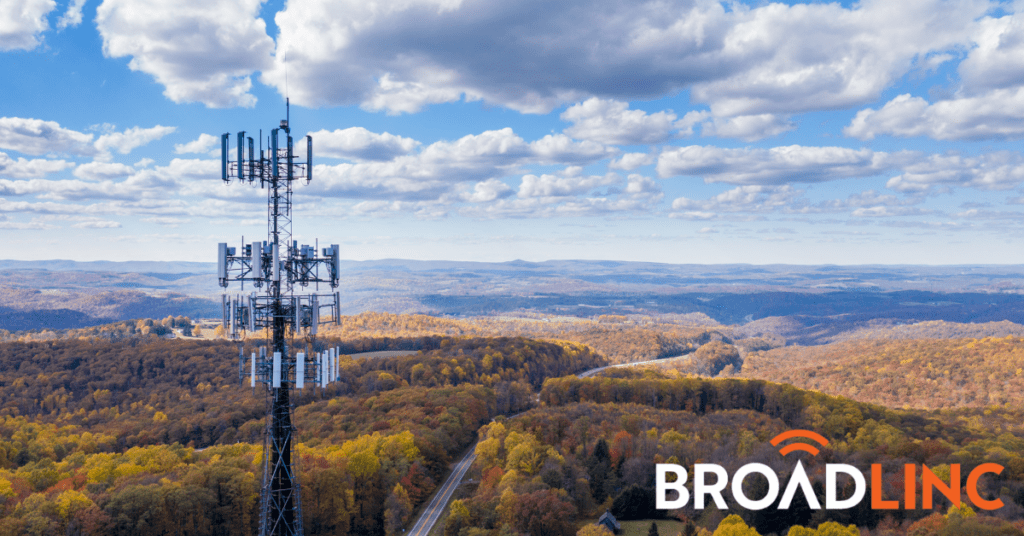
Where To Find Unlimited Rural Internet?
More and more, people are dependent on the Internet for daily living. Working from home allows people to work various jobs without commuting or moving to an expensive area. Online education means you can save money on the cost of college. Not to mention, we rely on the Internet for entertainment, from streaming to gaming.
However, finding a fast Internet service in a rural area can be challenging. Not only that, but finding a rural Internet service that gives you unlimited data is also a difficult task. Many rural Internet providers will have data caps. Streaming video and voice chatting can use plenty of data, so you want an Internet service that lets you use as much data as possible with no extra fees.
So, what’s the best unlimited rural Internet service? Let’s find out.
What is the Best Internet for Rural Areas?
Until recently, you could only find slower Internet service providers. However, this is quickly changing, with many rural Internet service providers offering faster speeds and unlimited data plans.
Broadlinc provides high-speed cable, fiber, and fixed wireless Internet with unlimited data packages. Our speeds allow you to enjoy the Internet’s modern luxuries across multiple devices. We’re bringing broadband connection speeds to Kentucky, and we currently serve areas in these counties: Bullitt, Muhlenberg, McLean, Boone, Owen, Gallatin, Henry, Wayne, Ohio, Daviess, and Carroll.
Our Internet service is for Kentuckians, by Kentuckians. If you live in the above counties, see if your area has access to our unlimited rural Internet plans.
The Importance of Unlimited Rural Internet Providers
Recently, there have been more rural Internet options available besides DSL Internet. Here’s why this is a good thing.
Promotes Rural Small Businesses
Small businesses may need fast Internet service to sell their products, especially if they are online. However, some Internet in rural areas can make running a small business much more challenging.
Video Calls Are Easier
Video calls require a fast rural Internet connection. If you’re working or receiving an education from home, your client or professor may need you to video call a lot, which can be challenging with slow Internet speeds.
It’s Great for Farmers, Too!
Today’s smart technology streamlines farming, from sensors to WiFi cameras. However, these technologies require fast Internet speeds, which can be challenging. Fast rural Internet options can fix this.
It Builds Community
With fast Internet providers, you can see who is in your area. You can gain new friends or see what’s happening in your area when you’re always connected.
Better Healthcare
Going to one can be challenging when you live far from a doctor. Telemedicine gives you access to a doctor or therapist whenever you need it.
What Type of Internet is Typically Offered Throughout the Rural Areas?
Rural Internet options can be limited, but this is changing. Let’s look at some Internet providers you may find in rural areas.
Satellite internet
Satellite Internet uses a satellite dish from space and a receiver from home to give you Internet. Regarding rural Internet options, satellite Internet is popular because it helps isolated areas access the Internet.
Satellite Internet speeds can vary, but some Internet providers offering it can give you speeds surpassing 100MB, which is enough to enjoy the modern Internet. With that said, satellite Internet does have its downsides. For one thing, you may experience a drop in download speeds or ping during bad weather. Another downside is that satellites can be pricey. However, this depends on what provider you choose.
Mobile Broadband
Mobile broadband is the Internet that you access through cell phone towers. Some mobile broadband providers will give you a receiver. Others may receive Internet by creating a hotspot with their mobile device.
It can be a cheap way to get Internet service, especially if you already have a phone. However, the speeds can vary depending on how much signal you receive. Mobile signals may be sparse in many rural areas, so this may not be ideal if you want fast rural Internet speeds.
Dial-Up
Dial-up Internet uses a phone line and an analog modem to access the Internet. However, dial-up is infamous for having slow Internet speed, and people have moved past it in most places. You should look towards faster options if you’re in a rural area.
Fixed Wireless Internet
Fixed wireless comes from local Internet providers, who use a radio tower to transmit a signal to a fixed receiver. As long as the customer lives within a 10-mile radius of the tower and has no obstructions, fixed wireless can give fast download speeds.

What to Look for in a Rural Internet Provider
Rural Internet users should expect quality when searching for a rural Internet provider. Here are some considerations when searching for a provider.
High-Speed Internet
In today’s world, slow download speeds are unacceptable in rural areas. With slow speeds, you will struggle to stream high-quality entertainment, video chat with others, and upload large files.
How fast your download speeds should be depends on what you want to use the Internet for and how many people will use it. That said, it should at least meet the current standard for broadband. The FCC defines broadband as at least 25 Mbps in download speeds and 3 Mbps in upload speeds.
Unlimited Data
Some Internet providers will have data caps. In other words, they will give you the maximum amount of data you can use. If you don’t plan to use your Internet much, data caps may not hinder you. However, if you stream Netflix, need to upload large files, or do any other demanding task, it’s easy to go over the data caps.
Always read the fine print. Some providers will stop the service until your caps reset, while others will give you free, albeit slower, Internet. However, some providers will start charging extra fees, which can add up! You may end up paying hundreds if you’re not careful. The solution is searching for an Internet provider that gives you free unlimited data plans.
Good Pricing
How much you pay every month can depend on the provider and what type of service you have. That said, you want to ensure you’re getting your money’s worth. If what you get seems too much, you may want to look somewhere else or see if you can haggle. Some providers will give you a deal.
Reliability
Besides being fast, your unlimited rural Internet should be reliable. In other words, it should have little lag and a fast response time. Reliability can depend on which Internet service you choose. For example, it may be less reliable if you choose satellite Internet and live in a stormy area. Unreliable Internet can mean that your Internet service goes out when you need it the most, or you lose the game when you’re about to win.
Why Are Most Rural Internet Services Bad?
Lately, there is talk of the Digital Divide, where people in rural areas do not have access to high-speed Internet service. Rural Internet tends to rely on aging infrastructure, such as phone lines, with many Internet companies refusing to expand to rural areas because of the lack of a profit incentive.
However, this is changing. Many local rural Internet providers are now bringing fiber, fixed wireless, cable, and other broadband options to rural areas.
How Do You Get Internet to Rural Areas?
Rural Internet providers can vary, so it’s vital to research and see what the options are in your area. If you live in an isolated area, your options may be limited. Often, you will find that you have access to satellite Internet, however.
Are Satellite Internet Providers Expensive?
It depends on the provider and the area you’re in. Satellite Internet providers can range from $50 to $100 a month, but some will be cheaper or more expensive.
How is Broadlinc ISP Changing the Rural Internet World?
Rural Kentuckians have had few options for too long, primarily relying on slow speeds, unreliable connections, and providers that charge more for less. We at Broadlinc saw this and decided to bring fast rural Internet at competitive prices. Because we are locally owned, it’s much easier to speak to someone about any questions or concerns you may have. We don’t believe in spending hours talking to a human being, which many Internet service providers sadly think.
What Are Broadlinc ISP’s Coverage Areas?
Currently, we have coverage in these counties:
- Bullitt
- Muhlenberg
- McLean
- Boone
- Owen
- Henry
- Gallatin
- Wayne
- Daviess
- Ohio
- Carroll
Does Broadlinc ISP Plan To Expand Their Coverage?
Yes! We want to expand to other areas in Kentucky, and we won’t rest until all counties in Kentucky have access to high-speed internet. If your area doesn’t have access to our Internet, let your voice be heard. Check our news section to see the latest updates.
What Does Internet Access Mean for Rural Communities?
Did you know that four of the five counties with the least broadband Internet access come from rural counties? Here’s why rural communities having access to high-speed Internet is a good thing.
Closing The Digital Divide
The digital divide means rural Internet tends to be slower and less reliable than high-speed Internet in urbanized areas. By giving unlimited rural Internet service to these communities, people living in these areas can have more opportunities, such as working and receiving an education, without going far.
Access To Educational Resources
Besides taking online classes, unlimited rural Internet means users can access the latest educational resources. While libraries are important, they often contain outdated educational materials.
More Work Opportunities
Remote working means that you can make good money without having to commute. Beforehand, people in rural areas had to work locally, which meant that the opportunities and pay were little, or they had to commute or move great distances. Now, it’s possible to work from home.
Understanding Data Caps: Why Some ISPs Implement Them and How Broadlinc Stands Apart
In recent news, the Federal Communications Commission (FCC) has shown interest in investigating the usage and impact of data caps imposed by Internet Service Providers (ISPs). Data Caps and limited data on home internet has been a hot topic following the COVID-19 pandemic. Other ISPs implement data caps as a means to manage network congestion and ensure fair usage among their subscribers. These caps limit the amount of data consumers can use within a specific billing cycle. When users exceed their allotted data limit, ISPs may throttle their connection speeds or charge additional fees. However, Broadlinc takes a different approach, building its networks to have sufficient bandwidth capacity to meet consumer demands without resorting to data caps.
Here are some technologies that often implement data caps in their networks:
DSL:
Digital Subscriber Line (DSL) providers typically rely on existing telephone lines to deliver Internet service. While DSL technology has served many areas well, it often struggles to provide high-speed connections due to limitations in bandwidth. As a result, DSL providers may impose data caps to manage their limited network resources effectively.
5G Home and Mobile Internet:
With the advent of 5G technology, mobile network providers have made significant strides in delivering faster Internet speeds. However, the widespread implementation of 5G networks is still ongoing, and coverage in rural areas may be limited. Additionally, some 5G providers have employed data caps to prevent network congestion and maintain quality of service, especially during peak usage times. It is to be noted, that Broadlinc’s Fixed wireless/5G networks are different, as in we do not implement Data Caps.
GEO/LEO Satellite Providers:
Satellite Internet providers, whether using Geostationary Earth Orbit (GEO) or Low Earth Orbit (LEO) satellites, face unique challenges due to the vast distances signals must travel. While satellite Internet has enabled connectivity in remote areas, it often suffers from limited bandwidth, higher latency, and potential weather-related disruptions. Consequently, GEO/LEO satellite providers may implement data caps to manage network load and provide a consistent service to all subscribers.
Broadlinc’s Network Design:
Broadlinc differentiates itself from other ISPs by prioritizing network planning and infrastructure to accommodate the needs of its customers without resorting to data caps. By investing in sufficient bandwidth capacity and utilizing industry-leading Quality of Experience (QOE) tools, Broadlinc ensures that users can enjoy high-speed Internet without arbitrary limitations on data usage. This approach allows subscribers to stream, work, and connect without worrying about reaching a data cap or facing speed reductions.
By offering unlimited Internet without data caps, Broadlinc empowers its customers to fully utilize online services and applications. This is particularly crucial in today’s digital age, where remote work, online education, video streaming, and other bandwidth-intensive activities are commonplace. Broadlinc’s commitment to providing unrestricted access to the Internet enhances the overall user experience and fosters productivity and growth in both residential and business settings.
As the FCC examines the impact of data caps on consumers, it is essential to understand why ISPs implement such restrictions. While DSL, 5G, and GEO/LEO satellite providers may rely on data caps to manage limited network resources, Broadlinc takes a different approach. By meticulously planning its networks to have sufficient bandwidth capacity, Broadlinc proudly offers unlimited Internet without data caps, allowing users to make the most of their online experiences. As consumers, it is vital to consider these factors when choosing an ISP, ensuring that our Internet usage remains unconstrained and our digital lives unhindered.
Sign Up With Broadlinc ISP Today!
If you live in an area with coverage, it is worth checking out Broadlinc. We’re giving faster options for rural communities in Kentucky, with fair prices and staff from Kentucky.
Our Internet packages go up to 200 Mbps, enough for a family to enjoy the modern Internet without slow speeds. Stream, game, talk, and do whatever you want!
Besides our Internet, we also offer cable TV packages, giving you full HD channels for an affordable price. We also offer digital phone lines, letting you call people without the bells and whistles of smartphones but without the outdated technology of traditional phone lines. Finally, we offer custom packages for your business needs. You can create a package that has everything your business needs without spending any more.
Contact us today, and see how we can help you. Chances are, we can make your Internet experience much better!

Written By Brittany Derderian, Director of Marketing
Brittany Derderian is the Director of Marketing at Broadlinc internet services. Her responsibilities include leading the company’s marketing efforts, overseeing and growing the marketing department, consistently identifying revenue opportunities within our established client base and managing consistent growth by securing new accounts, collaborating with the leadership team to uncover insights and strategies to develop and implement marketing and branding strategies for new and existing products, and spearheading the strategic and tactical execution of marketing campaigns, including design of test/control segmentation, implementation of tests, tracking, results reporting, analysis, and recommendations. You can find her on the weekends enjoying the outdoors of Colorado with her husband, Logan Derderian.
Employee Spotlight: Aaron Parker
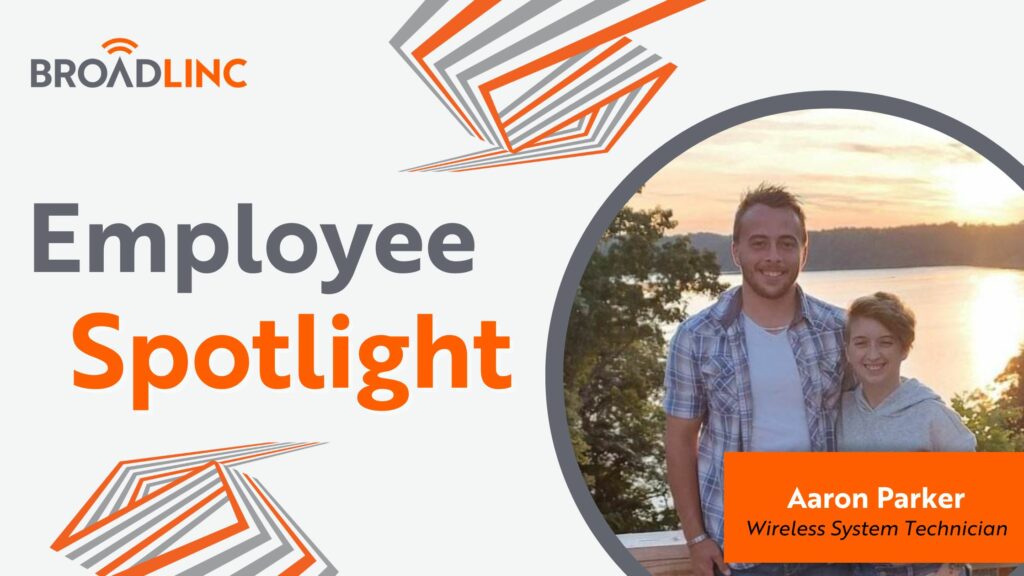
Meet Aaron Parker
Meet our employee spotlight for June, Aaron Parker! As a Wireless System Technician based in Monticello, he diligently oversees inventory and executes installations and service calls while ensuring that the systems run smoothly. If you’ve ever had one of our expert crew members install our service at your home, Aaron most likely led the charge!
Q & A with Aaron
Tell us a little about yourself.
I’m Aaron Parker, and I’m 25 years old. I was born in Kentucky and raised in Ohio. I moved back to Kentucky with my wife, Emily, a couple of years ago, and we always liked the view of the rolling hills better than the corn fields up there.
How long have you been with Broadlinc?
I’ve been with Broadlinc for over a year.
What brought you to the company?
I have always enjoyed the tech field and saw this as an opportunity to get a start in it.
What do you like most about being a Wireless System Technician?
I enjoy the challenges that can come with the job. It forces you to treat each job a little differently; it’s always different.
What are you most proud of in your career so far?
I’m proud to be on the ground floor of future expansion in Monticello. It’ll be exciting to see Broadlinc grow here.
What advice would you give to someone that wants to pursue a career in your field?
My advice would be to ask questions. The tech field is constantly changing. If you don’t stay on top of it and get help when you need it, it’s easy to get overwhelmed.
How would you describe the culture at Broadlinc?
Broadlinc is unlike any company I’ve worked for. When they say treat each other like family, they mean it. I’m glad to be a part of the team.
What do you like most about the work we do at Broadlinc?
It changes people’s lives in different ways. For some, it saves them money to switch from cable. For others, it just opens opportunities they never had.
What do you enjoy doing in your spare time?
My wife and I are gamers, and we like visiting new places, so we try to have a mix of both.
If you could have any superpower, what would it be and why?
I’d choose the power to fly; it would really reduce installation times.
What’s one thing on your bucket list?
My bucket list item is to own a Virtual Reality arcade. It’s always been my goal to have a place where people can relax and have fun. Working around people and tech like that is where I can excel.
What piece of advice would you give to your younger self?
My advice would be not to worry so much. Everything worked out. I ended up with the perfect person, a great job, and a world of opportunity.

Written By Brittany Derderian, Director of Marketing
Brittany Derderian is the Director of Marketing at Broadlinc internet services. Her responsibilities include leading the company’s marketing efforts, overseeing and growing the marketing department, consistently identifying revenue opportunities within our established client base and managing consistent growth by securing new accounts, collaborating with the leadership team to uncover insights and strategies to develop and implement marketing and branding strategies for new and existing products, and spearheading the strategic and tactical execution of marketing campaigns, including design of test/control segmentation, implementation of tests, tracking, results reporting, analysis, and recommendations. You can find her on the weekends enjoying the outdoors of Colorado with her husband, Logan Derderian.
Employee Spotlight: Gage Hales

Meet Gage Hales
Meet our employee spotlight for May, Gage Hales! As a skilled Premise Technician based out of our Bremen office, Gage takes charge of vital responsibilities such as efficiently setting up, preserving, and fixing broadband, WiFi, phone, and TV services. He is also an adept troubleshooter, conscientiously addressing any broadband network issues and providing valuable support to his team during outages and upgrades. If you recently subscribed to our services in Bremen, it’s likely that Gage swiftly set up your connection!
Q & A with Gage
Tell us a little about yourself.
My name is Gage, and I’m from Russellville, KY. I currently reside in Bremen, KY! I’m 28 years old and married to a beautiful Woman with two lovely daughters, River & Wrenley!
How long have you been with Broadlinc?
I’ve been with Broadlinc for almost two years now.
What brought you to the company?
I met a man named Keith, and he told me how great of a job it is, and the rest was history.
What do you like most about being a Premise Technician?
What I like most about my job is visiting with the customers, getting to know them, and meeting new people.
What are you most proud of in your career so far?
What I’m most proud of in my career is how it has opened me up to be more of a people person and not standoffish.
What advice would you give to someone that wants to pursue a career in your field?
My advice would be to pay attention to detail and just be yourself with every customer.
How would you describe the culture at Broadlinc?
The culture at Broadlinc is better than anywhere I’ve ever been employed. Every employee treats one another respectfully, and everyone gets along well.
What do you like most about working for Broadlinc?
Every day is different; no day is the same as the next!
What do you enjoy doing in your spare time?
In my spare time, I enjoy being in the woods hunting or on the water fishing with my family!
If you could have any superpower, what would it be and why?
If I could have any superpower, it would be the ability to fly!
What’s one thing on your bucket list?
One thing on my bucket list is becoming a certified skydiver.
What piece of advice would you give to your younger self?
Never take any moment for granted, and always live in the moment!

Written By Brittany Derderian, Director of Marketing
Brittany Derderian is the Director of Marketing at Broadlinc internet services. Her responsibilities include leading the company’s marketing efforts, overseeing and growing the marketing department, consistently identifying revenue opportunities within our established client base and managing consistent growth by securing new accounts, collaborating with the leadership team to uncover insights and strategies to develop and implement marketing and branding strategies for new and existing products, and spearheading the strategic and tactical execution of marketing campaigns, including design of test/control segmentation, implementation of tests, tracking, results reporting, analysis, and recommendations. You can find her on the weekends enjoying the outdoors of Colorado with her husband, Logan Derderian.
Fixed Wireless Internet For Gaming

Fixed wireless Internet for gaming
Fixed Wireless Internet Basics
Finding a reliable Internet service in a rural area doesn’t have to be complicated. Fixed wireless Internet is steadily becoming an option for those who need broadband services. It does not require any cable or phone lines, and it can give you speeds to let you do all your favorite activities. However, you may ask, “Is fixed wireless Internet good for gaming?” The answer is yes, with many fixed wireless users having a satisfying gaming experience.
Read on to learn why it can level up your gaming experience and let you have other Internet experiences that a slow connection cannot bring.
How Fixed Wireless Internet Works
Fixed wireless Internet providers use towers to broadcast a signal, which homes receive through fixed wireless antennas installed by the provider. A fixed wireless Internet service provides users with reliable speeds as long as they live in a house 10 miles or fewer from the tower and don’t have any major obstructions.
Advantages of Fixed Wireless Internet
Fixed wireless Internet gives homes that do not have Internet access or can only access DSL (digital subscriber line) the ability to have fast speeds.
Faster, Hassle-Free Implementation
Fixed wireless providers do not need to bury cables to bring them to your home. Instead, they install a receiver and connect it to a router. Once it’s all set up, users will receive an Internet connection provided they are near a tower. This ease also allows fixed wireless providers to expand into rural and underserved areas for less time and money.
Access in Remote Areas
Many high-speed Internet services will only expand to rural areas if they have a profit incentive. However, creating a fixed wireless connection costs much less, and it’s helping bridge the digital divide many rural areas experience.
High-Speed Connections
Fixed wireless Internet gives users much higher speeds and lower latency than DSL. This means that users can stream 4K video and online game without lag, use multiple devices, and download files much faster.
Increased Reliability
There’s nothing worse than weather knocking out your signal when you need it the most. Fixed wireless Internet is much more reliable as long as you’re within range, meaning you’ll always stay connected.
Leverage for Radio Innovations
Fixed wireless Internet service is easily upgradable because the networks do not require as much power. In addition, it opens the door to more innovations such as LTE air interface, carrier aggregation, and much more. In other words, it can bring quick, advanced technologies to your doorstep.
Re-Use of Mobile Infrastructure
Many high-speed Internet options do not make it to rural areas because of the cost of building new infrastructure. However, fixed wireless Internet uses previously built phone towers, thus reducing the need for new infrastructure. There are exceptions, such as the need for new hardware, but it still costs much less than building a tower from scratch.

Using Fixed Wireless Internet for Online Gaming
Gaming with a slow Internet connection is challenging. If you’re online gaming, you must deal with lag, dropped connections, and downloading updates that take a long time. You can be on top of your game in CoD, Fortnite, or another competitive game, only for a slow, unreliable connection to make you lose. And no opponent takes a bad connection as an excuse!
However, fixed wireless Internet for gaming means you can have a much better gaming experience. First, it leaves room for multiple devices, meaning you and your friends can have a match in the same house.
Fixed wireless Internet for gaming means that you don’t have to deal with the slow speeds of DSL Internet or worry about the low ping rate and the unreliable service that satellite Internet can unfortunately bring. You can still play with a fast connection even on a rainy day.
It would be best to have a consistent Internet connection as long as your home is under 10 miles from the tower and is not heavily obstructed. Many rural gamers are switching out their DSL or satellite Internet connection for a fast, stable, fixed wireless service, and it’s easy to see why when you look at what your games may require.
Internet Service Speed Requirements for Online Gaming
How fast your Internet connection should be can depend on what console or PC you’re playing it on and the game you are playing. Most consoles require a minimum of 3 MBPS to run. However, for the smoothest experience, you may need more. Many games recommend a speed of at least 25 MBPS if you want a smooth experience.
Xbox Series X and S
If you’re playing CoD or Halo Infinite, meeting the requirements can distinguish between being on top or waiting to respawn.
Xbox’s latest consoles require a minimum download speed of 3MBPS, an upload speed of 0.5 MBPS, and a ping under 150 ms. As mentioned, however, you may need a much higher speed.
PlayStation 5
Sony’s latest incarnation of the PlayStation delivers faster load times thanks to its SSD. However, you still need a reliable Internet service to game on it. Like Xbox, 3 MBPS is the bare minimum, but you may want something faster to keep up.
If you own a digital edition of the PS5, you may want faster download speeds to get your games faster. For example, God of War: Ragnarok is 96 GB. If you have a slow connection, it may take as long for you to download the game as it takes to complete Kratos’s epic journey.
Nintendo Switch
The Switch is a unique console; you can play it docked on a TV or use it as a portable device. Because of this, a robust wireless Internet connection is even more critical. With a slow connection, Mario Kart will feel as thrilling as being stuck in rush hour traffic.
It would be best to have a minimum speed of 3 MBPS for downloading and 1 MBPS for uploading, so be sure you have that before you’re ready for a fun gaming night.
PC Gaming
Some gamers play through their PC. A PC gives you more hardware choices, meaning your requirements can significantly vary. As such, the Internet speed requirement is minimally 3-6 MBPS. Once again, you will want a much faster speed.
Besides, for online gaming reasons, PC gaming is all-digital nowadays, with many PCs no longer having a disc drive and few PC games being physical. As such, the need for strong download speeds is arguably more than consoles, which still have physical games for their physical iterations.

Written By Brittany Derderian, Director of Marketing
Brittany Derderian is the Director of Marketing at Broadlinc internet services. Her responsibilities include leading the company’s marketing efforts, overseeing and growing the marketing department, consistently identifying revenue opportunities within our established client base and managing consistent growth by securing new accounts, collaborating with the leadership team to uncover insights and strategies to develop and implement marketing and branding strategies for new and existing products, and spearheading the strategic and tactical execution of marketing campaigns, including design of test/control segmentation, implementation of tests, tracking, results reporting, analysis, and recommendations. You can find her on the weekends enjoying the outdoors of Colorado with her husband, Logan Derderian.
Does Faster Internet Speed Increase WiFi Range?
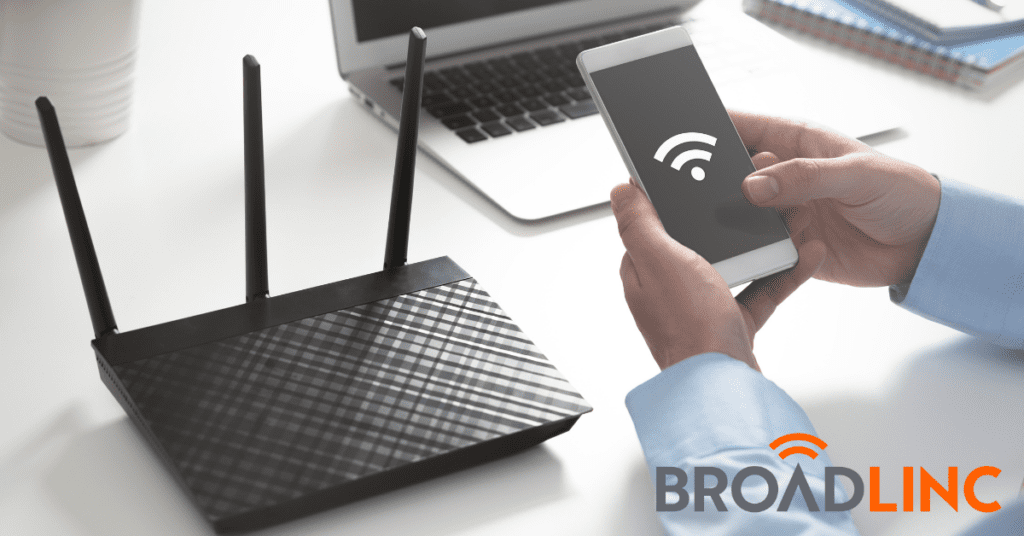
Does Faster Internet Speed Increase WiFi Range?
A wireless network can give you Internet without a cable, but sometimes, the signal can be weak. If you’re trying to get work done or just want a fast connection to stream content, it can be a frustrating experience. You may wonder if a faster internet connection l can increase the range of your wireless Internet connection.
The answer is no. WiFi signal is not reliant on faster speeds. To increase your Wi-Fi signals, move your existing router, or upgrade to a mesh Wi-Fi network.
Read on to learn how Wi-Fi and Internet speed relate and how you can wirelessly get a strong Internet connection.
Want To Make Your Life Easier? Our Plume Whole Home WiFi offers advanced AI-powered WiFi management through Plume HomePass, so you don’t have to!
The Relationship Between Internet Speed and WiFi Range
Some people have Wi-Fi problems, and they believe that increasing Internet speed will improve their Wi-Fi performance. In some cases, they may pay more for faster Internet.
However, these two are not related. Internet speed refers to how much data is transferrable through an Internet connection. Meanwhile, Wi-Fi range refers to how far a wireless signal can travel and still allow you to connect.
If you have faster Internet, your Wi-Fi connection speed will increase if your range is good. However, increasing your speed will not increase your range.
Factors That Influence WiFi Range
With that said, what does influence the Wi-Fi range? Several factors influence Wi-Fi range, including:
- The type of Wi-Fi router you have and its power
- How far you are from the WiFi router
- Walls, furniture, or any other obstructions
- Frequency band
If you move closer to the WiFi router, move the router to a central location, or upgrade to a mesh system, you may get a better signal.
Understanding the Role of the Wireless Router in a Wi-Fi Network
So, what is a wireless router? It allows people to wirelessly connect to an Internet network, acting as its gateway. In addition, the router can allow for a wired connection or be the network’s centerpiece. Knowing a wireless router can help you understand how to get the best Internet connection.
Wireless routers can come in several types, many of which cover different ranges or are tied to your ISP. When you’re investigating your router, be sure that you know its specs. You can find that on the back of the router, or by contacting your ISP.
Ways to Improve WiFi Range
First, your router needs to be in an ideal location. For example, putting the router inside a cramped room may not have much signal. However, you may increase your range if you put it in an open area, such as the living room.
In addition, buy a router that fits within the square feet of your home or office. If you live in a bigger house, a router with a short-range may not cut it. If your router is older, consider upgrading it as well.
Another solution, if you don’t want to replace your router, is to purchase a WiFi booster or extender. This device can extend the range of your router, giving you a steady Internet connection. Wi-Fi extenders cost little, and you can save money by buying a new router. However most Wi-Fi extenders require the users to choose between the extenders Wi-Fi connection or the main router when moving around the home. For this reason, and the possibility of interference bing introduced by these devices, we don’t recommend them anymore.
The best solution, in our opinion is a mesh Wi-Fi system. Our Plume HomePass Whole Home WiFi system is a mesh system. With these systems, instead of having a single router in one location, you have multiple mesh extenders that bring the Wi-Fi signal closer to your users. When done right, a mesh Wi-Fi system can reduce interference and drastically improve the experience. Also with a mesh system, your wireless devices connect to the extender with the best signal automatically and there is only one network to connect to.
If you feel your range is impaired due to interferenc,e you can change the frequency of your Wi-Fi signals. To do this, refer to your router’s user manual to change the Channel Selection. From there you can change your channel and give it a different frequency. Many routers have an automatic option that “listens” for the best channel to operate in based on interference it may detect.
It requires trial and error. If you’re not noticing a change in your speed, please contact your Internet service provider. It could be another connection issue.
Maximizing Wi-Fi Signal Strength for Optimal Network Performance
Being in an area with the best WiFi strength is ideal. However, if your connected device is only getting a couple of bars, you will deal with slower and unreliable speeds.
As mentioned, look for an area where your Wi-Fi router can send its signal freely. Avoid putting it near furniture, in a smaller room, and in an area where you won’t use your devices.
Also, you must be mindful if you have multiple routers and the range extenders mentioned above. Multiple devices can interfere with each other if they’re too close together, causing issues with your Internet speeds. So put them as far as possible to ensure faster Internet speeds. Mesh network extenders such as the ones we use with our Plume HomePass Whole Home Wi-Fi are designed to work in conjunction with one another.
It is to note, many connected devices such as smart TV’s and printers create their own hotspot network for “guest” or setup access and are one of the worst offenders when it comes to what we call “rogue” Wi-Fi signals. Be sure those devices are connected to your home wifi and their settings for direct connection are turned off (see those devices owners manuals for more information on how).
Also, if your router is older than five years, or if it is an inexpensive model, you may want to consider an upgrade. Modern routers have better signals, ensuring better network coverage throughout your home.
Finally, you may want to consider an ethernet cable. While wireless connections can be more convenient, a wired connection ensures more reliability and saves your Wi-Fi bandwidth for devices that need wireless signals. You may use this when doing more demanding tasks, such as streaming video games or downloading a large file. While a strong Wi-Fi speed can suffice, it is limited. If your router has ethernet ports, consider plugging some cables in there and be sure to use a cable that can support the speeds you need.

Troubleshooting Common Wi-Fi Network Issues with Your Wireless Router
If you’re still having Wi-Fi signal issues, please contact your ISP. However, if they aren’t providing the Wi-Fi router, their help may be limited. . Before calling them, here are some things you can do to troubleshoot it yourself.
With that said, it can be a daunting task to troubleshoot. Before you worry too much, let’s discuss some of the best ways to troubleshoot your wireless networks.
Be Sure You Have a Strong Signal
Before testing, ensure you’re in an area with a full connection. For example, be in an open area, and have a clear line of sight to your router. This ensures you get the most reliable results if you do a speed test.
Change the Channel
If you go to your router settings, you may notice that you have changed your channel, which changes the signal frequency. Why does this matter? Having other devices with the same signal can lead to crowding, which can lower speeds. Changing your channel can be a quick way to troubleshoot your wireless router.
Update Router Firmware
Sometimes, your wireless router is outdated, which can interfere with its performance. Bugs or hacker exploits can lead to your router becoming slow. The goal of updates is to patch any issues that can occur and to improve performance.
Visit your router’s website to learn how to download and install the latest firmware. Be sure to turn on automatic updates if possible. This way, you do not have to search for updates constantly. With that said, it’s still worth it to check for an update every few months to ensure that you’ve installed everything, as some optional updates may not be installed.
If you’re unsure, contact your Internet provider to learn how to do this.
Go to Your Router’s Settings
Sometimes, playing around with your router’s settings can help you. When you visit the router settings, be sure that you try changing some things around. For example, if your encryption is WEP, change it to WPA2 or WPA3, the industry standard. Also, disabling WPS can prevent hackers. If you’re unsure of which settings to use, you can contact your ISP. In addition, if someone changes the current settings, you may want to reset them.
Replace Older Routers
Technology is constantly evolving, so it makes sense that you need to replace your routers. If your router is over five years old, replace it with a newer one for the fastest Internet connection. You may also want to contact your ISP to see what the best, newest router you should be looking for.
Consider an upgrade even if your router is only a couple of years old. With the fast technology moves, even newer routers can bring slower speeds.
Check Your Cables and Connections
Sometimes, your router may be faulty if your cables are not connected. If your router’s connection is loose, fix that. Look around for any tears in the cable. If you’re still unsure, you should buy a new cable and see if that fixes the problem.
Ensure you purchase your cables from a website where the return policy is lenient. This way, you can return the cables if you rule out they were an issue.
Check Your Router’s Placement
Many people do not realize that a single router can be ruined if it’s in an area with obstructions. We’ve mentioned putting it in a larger room with little furniture or walls to interfere. In addition, we stress that you make sure it’s in an area without device or appliance interference. Finally, put any unused devices in another room. These devices can include baby monitors, smart thermostats, or other items that rely on the Internet.
Reboot Your Router
“Have you tried turning it off and on again?” It’s generic advice, but that’s for a reason. Quite often, a restart can fix any problems. But, unfortunately, technology can sometimes have no real solution other than giving it a reboot.
To reboot your router, be sure that you unplug its power cord. Please wait a few minutes so that the electricity is drained from it. Then, plug it back in, and wait a few minutes for it to start fully. Once you see the lights turned on and solid, you can check your connection. If it’s better, then great. If not, then you may need to:
Contact Technical Support
It may be an issue with your ISP or the router if all else fails. Therefore, you must contact your ISP. Your ISP could send someone to investigate the cause of your faulty connection or replace your router altogether.
Let your ISP manage your Wi-Fi
If all of this is too challenging for you, see if your ISP has a managed Wi-Fi service. This is usually available for an additional fee, but is well worth the money. At Broadlinc, we know our customers have better things to do, and they expect us to be the experts on Wi-Fi. So because of that we offer our Plume HomePass Whole-Home Wi-Fi service. With managed wifi, the ISP can see signal quality, and guide decisions to maximize performance and experience.
Conclusion
Your WiFi signal is not reliant on the speed of your Internet plan. Instead, it can depend on where the router is, its age, or your device’s distance from it. In addition, signal interference can lead to your router not giving you the best connection.
Move your router around and avoid furniture or thick walls. Consider looking into newer routers if your router is a few years old. All significant devices should be near the access point for the best performance. In addition, most routers may need help if you live in a bigger home. Consider investing in a mesh Wi-Fi network if you’re encountering dead zones in your house. It can give you a faster connection through a stronger signal, which means more speed. Finally, if you have other wireless networks, be sure the routers are far away or do away with them..
If you’re still having problems, consider troubleshooting. Update your router settings, change the channel, and update your router. If your current router still has issues, you may need to upgrade or spend a few extra dollars and let your ISP manage your Wi-Fi for you..
We hope this article was helpful to you. Technology can be a hassle, but when you know what to do, you can save yourself plenty of headaches.

Written By TJ Scott, VP of Operations
Employee Spotlight: Blake Duncan

Meet Blake Duncan
Meet our employee spotlight for April, Blake Duncan! He is an integral team member, working as a System Technician out of our Owenton office. He is responsible for running new lines, fixing existing lines, and troubleshooting our systems to ensure everything runs smoothly. Blake’s tireless efforts and expertise have been instrumental in keeping our operations up and running, and we are grateful for his hard work and dedication. If you’ve ever seen a Broadlinc crew member at work on cable lines, chances are it was Blake!
Q & A with Blake
Tell us a little about yourself.
My name is Blake Duncan. I was born and raised in Owen County, and most of my family is from here.
How long have you been with Broadlinc?
I started working for Broadlinc in October of 2022.
What brought you to the company?
I was looking for a company that treats employees well, and from what I heard, Broadlinc was the perfect fit.
What do you like most about being a System Technician?
What I enjoy most about being a System Technician is that each day is different, and all the work is outside.
What are you most proud of in your career so far?
I’m not sure if there is one thing I’m most proud of. But, overall, I’m proud to help my friends, family, and the rest of Owen County get high-speed internet.
What advice would you give to someone that wants to pursue a career in your field?
Don’t be scared of heights or the cold!
How would you describe the culture at Broadlinc?
The culture at Broadlinc is awesome! Some days it doesn’t even feel like work.
What do you like most about working for Broadlinc?
What I like the most about Broadlinc is how everyone helps each other. It is a great work environment
What do you enjoy doing in your spare time?
I enjoy working out, fishing, golfing, and hanging out with friends and family.
If you could have any superpower, what would it be and why?
If I could have any superpower, it would be super speed.
What’s one thing on your bucket list?
One thing on my bucket list is to visit Mexico.
What piece of advice would you give to your younger self?
A piece of advice I would give to my younger self would be to strengthen my relationship with God. I would tell myself not to be tempted by things in this world and to keep my focus on Him; everything will work out just how it’s supposed to.

Written By Brittany Derderian, Director of Marketing
Brittany Derderian is the Director of Marketing at Broadlinc internet services. Her responsibilities include leading the company’s marketing efforts, overseeing and growing the marketing department, consistently identifying revenue opportunities within our established client base and managing consistent growth by securing new accounts, collaborating with the leadership team to uncover insights and strategies to develop and implement marketing and branding strategies for new and existing products, and spearheading the strategic and tactical execution of marketing campaigns, including design of test/control segmentation, implementation of tests, tracking, results reporting, analysis, and recommendations. You can find her on the weekends enjoying the outdoors of Colorado with her husband, Logan Derderian.
Employee Spotlight: Tiffany Epperson

Meet Tiffany Epperson
Meet our employee spotlight for March, Tiffany Epperson, the Technical Support Specialist who brings dedication and professionalism to our Owenton office. Tasked with the crucial responsibility of addressing customer calls and emails, Tiffany’s exceptional communication skills are evident in every interaction. Guiding customers through troubleshooting methods with patience and expertise, she ensures their issues are efficiently resolved. During outages, Tiffany is the vital link between our clients and technicians, balancing her keen ability to multitask. Additionally, she diligently attends to setting up service calls when required. So, if there’s familiarity in the voice of one of our support specialists you’ve conversed with over the phone, it’s highly likely you’ve had the pleasure of chatting with Tiffany!
Q & A with Tiffany
Tell us a little about yourself.
I was born and raised in Stamping Ground. I moved to Owen County roughly 11 years ago when I met my Husband, Derrick. We have two amazing kids, Landen and Sadie. In addition, we have four dogs and several barn cats, and a peacock.
How long have you been with Broadlinc?
I have been with the company for a little over a year and a half.
What brought you to the company?
I wanted to work closer to home and be closer to my kids for their after-school events. At the time, Broadlinc had an open position that checked both of those boxes!
What do you like most about being a Technical Support Specialist?
Every day is different, so it keeps me on my toes.
What advice would you give to someone that wants to pursue a career in your field?
Be patient; there’s always something new to learn!
How would you describe the culture at Broadlinc?
The culture at Broadlinc is close-knit; everyone is willing to help everyone.
What do you like most about the work we do at Broadlinc?
I like that we service small-town communities because we can develop relationships with those we serve.
What do you enjoy doing in your spare time?
I enjoy being with my family, sporting events, photography, hunting, and fishing.
If you could have any superpower, what would it be and why?
Oh, that’s an easy and hard one at the same time. It would be a combination of curing cancer and bringing back loved ones.
What’s one thing on your bucket list?
I’d love to see and experience Rome, Italy, and Hawaii.
What piece of advice would you give to your younger self?
Have faith; doors close so that better ones open. Then, you’ll end up right where you’re supposed to be.

Written By Brittany Derderian, Director of Marketing
Brittany Derderian is the Director of Marketing at Broadlinc internet services. Her responsibilities include leading the company’s marketing efforts, overseeing and growing the marketing department, consistently identifying revenue opportunities within our established client base and managing consistent growth by securing new accounts, collaborating with the leadership team to uncover insights and strategies to develop and implement marketing and branding strategies for new and existing products, and spearheading the strategic and tactical execution of marketing campaigns, including design of test/control segmentation, implementation of tests, tracking, results reporting, analysis, and recommendations. You can find her on the weekends enjoying the outdoors of Colorado with her husband, Logan Derderian.
Do I Need Gigabit Internet?

Do I Need Gigabit Internet?
Gigabit Internet is an Internet connection that offers a maximum of 1gbps (gigabit per second) of speed, or 1,000mbps (megabits per second). Internet users looking to upgrade their service may seek a gigabit connection. However, is it going a little overboard? Or is it ideal for you? If you’re new to this concept, it can be difficult for you to know these answers. We’re here to help. First, let’s look at the facts.
See Related: How Much Speed Do You Need?
Why do people feel they need a Gigabit connection?
Providers often offer gigabit Internet as a marketing gimmick in competitive markets, particularly in larger cities. Having it can be a bragging right, but there are only rare instances when you need all that speed. Also, many companies that offer gigabit broadband have higher costs and data caps. So you can’t even experience the full potential of your service.
Most people say they want a gigabit internet connection to stream a 4K video or game online. However, gigabit Internet speeds far exceed the requirements. For example, streaming 4K HDR video consumes 25mbps, a fraction of a gigabit connection. This example is also similar for online gaming.
They may also believe they must have a gigabit internet connection to work from home because of video conferencing and VPN usage. However, an HD video conference call on one of the most popular platforms requires – at the most – just under 4mbps up and down. VPN connection requirements may vary based on what you’re transmitting inside of it, but you can achieve a stable connection as low as 1mbps up and 10mbps down.
Hardware Limitations
Depending on your hardware, you may need an upgrade before reaching gigabit internet speeds. For example, you may need to upgrade your router, network adapters, and even your devices in your home to take advantage of a gigabit connection.
Good Reasons to Get Gigabit speeds
There are very few instances where a gigabit connection is necessary. That said, there could be reasons to get gigabit speeds. One example is if your home has many users that consume far more than the average home simultaneously. To know if your home is one of them, watch your throughput by looking at the throughput indicators in your router (if equipped) when everyone performs their usual activities. Are you consuming all of your subscribed bandwidth from your current connection? If so, you may need an upgrade but still, you may not be close to reaching what a gigabit connection offers.
Another reason why you need gigabit speeds is if you are transferring large files to and from offsite servers. For example, CAD designers, software engineers, video editors, and music producers may need the bandwidth a gigabit internet connection affords to quickly and efficiently transfer files. However, this is not a typical residential application.
While having a gigabit service brings truckloads of bandwidth, you do not want to overpay. Knowing what you need is ideal for getting the best value where you live. In most cases, you can get by with a fraction of the download speed.
The average person can get by with a service that fits their usage but charges less is more reliable, and is locally owned.
Why Can’t I get Gigabit Internet Where I Live?
Simply put, this stuff can be expensive the further from densely populated communities you live. Gigabit Internet requires fiber optic lines, or DOCSIS 3.1 Cable connections that cost more to build per mile than the average revenue per customer can support. When there are fewer homes per mile or many miles between clusters of houses, the cost to build gigabit internet is prohibitive and will require a provider to sell services at higher rates than the market will support.
Broadlinc Can Help You Reach Fast Internet Speeds
If you need fast Internet, Broadlinc is here for you. We offer cable and fixed wireless Internet to bring your home to broadband. Here’s what we offer.
Serving Rural Kentucky
For many decades, rural Kentucky has had to rely on Internet companies that don’t seem to care about them. Their packages only offer slow speeds, with many unable to enjoy the modern conveniences the Internet offers. Moreover, their services never seem to improve, their costs only go up, and their customer service is just as unreliable.
We knew Kentuckians deserved better. That’s why we’re working to bring broadband speed across rural Kentucky. Since we’re locally owned, we understand what Kentucky needs and want to connect to every user using our services.
Fast Internet
We offer fixed wireless Internet speeds that reach up to 50mbps, and cable internet speeds up to 200mbps. For many rural communities, these speeds should have been thought of before now. Our speeds allow you to watch 4K movies, online games, live stream, and use multiple devices without problems.
Our services use the latest tech to reduce latency and provide a more reliable connection. We’ve taken what people love about fixed wireless Internet and have taken out as much bad as possible to deliver fast Internet connectivity, as lag-free as possible, and enough for multiple users to enjoy.
Cable TV
Besides our Internet service, we also offer cable TV. With streaming services becoming divided, costly, and complicated, returning to the basics is not a bad idea. We have up to 250 channels of HD content, meaning you can enjoy everything TV offers without worry.
Phone
We offer a digital phone line for our customers. You can call an unlimited amount of times across all 50 states. Have all the modern conveniences such as caller ID, call forwarding, and three-way calls without a cell phone’s commitment and unreliable signal.
Bundles
Finally, we offer several bundled packages that you can use to get the most for less. If you’re a business, please tell us what you need, and we can help you get the best bundle.
Contact Us
While a gigabit Internet service can be excellent, many rural communities do not have access to it, and it can be excessive depending on your needs. Broadlinc offers a happy medium, giving you fast speeds for less money, and we serve the rural Kentucky community with pride. To see our coverage for your area and find the best plan for you, contact us; we’d be happy to give you the best Internet possible for your home. Join the fixed wireless revolution as we bring rural Kentucky out of slow DSL connections and unreliable companies.

Written By TJ Scott, VP of Operations
Employee Spotlight: Chris Hawkins

Meet Chris Hawkins
Meet our employee spotlight for February, Chris Hawkins, a System Technician at our Bremen office. He is responsible for service calls, installations, handling service outages, and line preventative maintenance. Chris takes pride in helping our customers get the most out of their technology and ensuring every installation or service call goes smoothly. If you’ve ever had the pleasure of meeting a Broadlinc technician from our Bremen office, it’s pretty likely that Chris was the friendly face at your door!
Q & A with Chris
Tell us a little about yourself.
My name is Chris Hawkins. I’m 36 years old and live in Bremen, Kentucky. I have a beautiful little family that includes four children, three girls and one boy ranging in age from 7 to 15, they are a handful, but I wouldn’t trade them for the world.
How long have you been with Broadlinc?
I have been with the company for almost three years.
What brought you to the company?
At the time, I moved into a new house and had my internet set up with Broadlinc, which had great deals on services I needed. When the technician came and set up my internet, we chatted a bit and had a great conversation. After a few days passed, one of Broadlinc’s trucks pulled into my driveway. So I went to talk to the man to see what the problem was, and he asked me if I would be interested in a job. Of course, I delightfully agreed and have been with the company ever since.
What do you like most about being a System Technician?
I like the ever-evolving environment of my job. I like that I never stop learning; there’s never a dull moment.
What are you most proud of in your career so far?
I don’t feel I have accomplished anything that I can genuinely say that I am proud of because I think there is always more I could do or improve on in my work.
What advice would you give to someone that wants to pursue a career in your field?
It’s an amazing job because there are always ways to grow and learn.
How would you describe the culture at Broadlinc?
Broadlinc has a very family-oriented and understanding culture.
What do you like most about the work we do at Broadlinc?
I like helping people.
What do you enjoy doing in your spare time?
I enjoy playing video games and spending time with my family and friends.
If you could have any superpower, what would it be and why?
It would be regeneration because I could live a very long life.
What’s one thing on your bucket list?
I would love to go skydiving.
What piece of advice would you give to your younger self?
Things I would tell my younger self sometimes would be you have to keep on keeping on, and life is a garden; dig it.

Written By Brittany Derderian, Director of Marketing
Brittany Derderian is the Director of Marketing at Broadlinc internet services. Her responsibilities include leading the company’s marketing efforts, overseeing and growing the marketing department, consistently identifying revenue opportunities within our established client base and managing consistent growth by securing new accounts, collaborating with the leadership team to uncover insights and strategies to develop and implement marketing and branding strategies for new and existing products, and spearheading the strategic and tactical execution of marketing campaigns, including design of test/control segmentation, implementation of tests, tracking, results reporting, analysis, and recommendations. You can find her on the weekends enjoying the outdoors of Colorado with her husband, Logan Derderian.
Fixed Wireless Internet vs. Satellite Internet
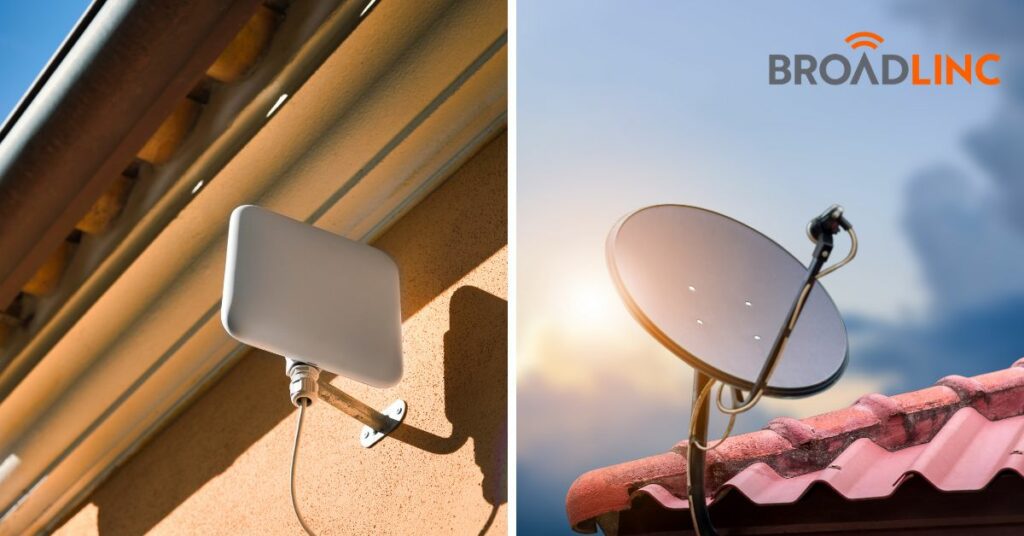
Fixed Wireless Internet vs. Satellite Internet
Two rural Internet options you have is fixed wireless Internet and satellite Internet. If you’re unfamiliar with either, you may not know the difference.
In short, fixed wireless Internet uses a radio tower, which sends a signal to a fixed point in your home. Meanwhile, satellite Internet transmits Internet signals from a satellite to a satellite dish receiver.
Of course, many other nuances exist between a satellite Internet service and a fixed wireless Internet service. Read on to learn which Internet service is right for you.
The Differences Between Fixed Wireless and Satellite Internet
A satellite Internet and a fixed wireless connection have many commonalities. Each Internet service provider type uses wireless technology that is picked up by a receiver. Both work well as rural Internet options when cable Internet or fiber is not available.
However, there are differences. Satellite Internet providers use, satellite technology. Satellite signals go from space to a satellite dish, providing Internet. Meanwhile, fixed wireless signals come from radio towers. A fixed wireless signal goes from the tower to a receiver, then is transmitted to a router.
Because of this, both have their advantages and disadvantages. Fixed wireless Internet can work well if you live in a home within a precise tower radius. Meanwhile, satellite can work well if you live in a secluded area or are on the road. Both satellite and fixed Internet have pros and cons, which we’ll get into later.
When it comes to fixed wireless Internet vs. satellite, you may wonder which is better for you. Both are broadband options for rural areas, so let’s discuss the advantages and disadvantages.
Advantages of a Fixed Wireless Internet Connection
Fixed wireless Internet providers use radio waves to bring the Internet to your home. But first, let’s look at why people choose fixed wireless services.
– Speed
Fixed wireless providers deliver faster Internet speeds. As long as your fixed wireless connection is in a 10-mile radius of the tower and there are no obstructions between the access point and your receiver, you can get download speeds up to 400 Mbps and upload speeds up to 50 Mbps.
With that said, fixed wireless Internet can vary widely depending on the location and your provider. When looking at a fixed wireless Internet provider, always ensure they can deliver faster. Read some reviews, see the averages, and don’t be afraid to ask questions.
– Cost
Fixed wireless providers tend to charge less. This is because installing a fixed wireless Internet connection is quick and affordable. In addition, fixed wireless companies offer various packages based on how many Internet and data caps you need, saving you money.
How much are you going to spend on average? It can depend on the fixed wireless Internet provider and how much you need, but most pay around $60 monthly. So compared to some providers, fixed wireless Internet can be affordable. However, you still get quality Internet service with every dollar.
– Reliability
For those living in a rural area, a fixed wireless connection provides more consistent speeds than a satellite Internet connection and a much faster speed than DSL. A good rural Internet option should be reliable. You don’t want the Internet to drop when you need it the most, such as during a crucial part of an online game, or when your 4K show is getting good.
However, it all depends on where you live. Fixed wireless Internet needs a clear line of sight; if you don’t have this, you may have to look elsewhere.
– Environmental Impact
Fixed wireless Internet service has become the more environmentally conscious option for some people. Fixed wireless Internet does not require physical cables and uses far less electricity, meaning that it produces less waste. Fixed wireless Internet needs a single tower and does not need to bury cables. Fixed wireless can be a better option with no fiber or cable lines.
Advantages of Satellite Internet
Like fixed wireless Internet, satellite Internet provides rural communities with faster, more reliable speeds.
– Availability
Since satellite Internet requires only a dish due to it beaming signals anywhere on Earth, one does not need to worry about it not being available. Therefore, satellite Internet options work well for those living in highly rural areas. In most cases, you can find someone to install a satellite dish or other wireless router in your home, meaning that you can access faster Internet speeds no matter where you are.
– Fewer Interruptions
While not perfect, a satellite service tends to have a consistent signal as long as it’s within clear sight. With that said, it can depend on where you live. Areas where you may experience storms often can fall victim to interruptions.
Disadvantages of Fixed Wireless Internet
With fixed wireless Internet vs. satellite, you must consider the disadvantages of both when you want to make a choice. Here is the disadvantage of fixed wireless services.
– Limited Coverage
Fixed wireless Internet can have impressive speeds and reliable service. One problem with fixed wireless Internet is that the point between your home and the radio tower must have no obstructions. If there are hills, trees, buildings, or other obstacles, your fixed wireless Internet connection may have slower speeds and higher latency.
In addition, you need to live in an area near a fixed wireless tower. If you don’t have an access point, then you can’t have fixed wireless, or you may have access to a slower version. So in the battle of fixed wireless vs. satellite, if you can get fixed wireless, fixed wireless wins. Ultimately, you can figure this out by looking up ISPs near you that offer fixed wireless or by checking for serviceability. If there aren’t any, then you may need to look elsewhere.
Disadvantages of Satellite Internet
Satellite Internet suffers from some problems as well. As you may expect, no Internet is perfect, and satellite does have several disadvantages. Let’s look at some of the major ones.
– High Latency
Unlike traditional cellular services, satellite Internet is not coming from Earth. Therefore, even though the Internet service uses signals at the speed of light, there can be high latency sometimes. This latency can increase if there are obstructions or during extreme weather.
You will notice this lag if your Internet usage consists of online gaming, streaming 4K video, or loading large web pages. With some providers, this latency prevents realtime communication such as voice over IP calling, videoconferencing, etc. While satellite Internet can have high download speeds, and Internet companies have been working to reduce latency, it can still be noticeable when it happens.
When choosing satellite Internet plans, you should also look at the company and its reputation. For example, do they often have interruptions, or is their technology better than other providers?
– High Cost
Satellite Internet providers can charge more than other broadband services. Of course, the price can depend on who you choose, where you live, and what plans you use. On average, satellite Internet costs around $110 monthly. This cost can be much more than other services, including fixed wireless Internet. However, the cost can be worth it if you live in an area where satellite Internet is your only option.
Also, it would be best if you considered the data cap. Some Internet plans offer data caps; if you go over them, your speed may be throttled, or you may pay more. Always discuss this before you choose a plan.
Conclusion
It all depends on what you need when it comes to fixed wireless vs. satellite.
A fixed wireless service uses radio waves to deliver high-speed Internet, which can be fast. However, the disadvantage of fixed wireless Internet is that you need a clear or near line of sight. If your home is in a forest or a hilly area, fixed wireless Internet may not be possible.
Satellite Internet is excellent if you live in a secluded area without Internet services. While you have to deal with high latency and weather issues, it can be a good choice if there is nothing else available.
Ultimately, both fixed wireless Internet and satellite are both excellent options. It may go down to where you live, what you need, and what’s available.
We hope this article was helpful to you. While living in a rural area can be a hassle for broadband Internet, things are changing. It’s now possible for you to get faster Internet, and both satellite and fixed wireless Internet are to thank for that.

Written By Brittany Derderian, Director of Marketing
Brittany Derderian is the Director of Marketing at Broadlinc internet services. Her responsibilities include leading the company’s marketing efforts, overseeing and growing the marketing department, consistently identifying revenue opportunities within our established client base and managing consistent growth by securing new accounts, collaborating with the leadership team to uncover insights and strategies to develop and implement marketing and branding strategies for new and existing products, and spearheading the strategic and tactical execution of marketing campaigns, including design of test/control segmentation, implementation of tests, tracking, results reporting, analysis, and recommendations. You can find her on the weekends enjoying the outdoors of Colorado with her husband, Logan Derderian.
How to Get Internet in Rural Areas

How to Get Internet in Rural Areas
Finding rural internet providers can be challenging if you live in a rural area. There are few of them, and the Internet service they provide tends to be slower and less reliable than urban Internet providers.
There are several reasons why finding a reliable Internet connection in rural America is challenging. One reason is that most Internet providers see little profit in having Internet services in rural areas due to fewer people.
Another reason is that some areas need more infrastructure for Internet service. This applies further if you live in a rugged area, making it difficult for high-speed Internet access to reach your home.
While this is slowly changing, the sad truth is that rural Internet service lags behind the rest of the world.
What Reasons Would I Need Rural Internet Service?
Having reliable Internet service in rural areas is vital in today’s society. Here are some reasons why rural communities need fast Internet connections.
Everyday Needs (Entertainment, socializing, etc.)
Reliable rural Internet services are vital for everyday needs. Let’s look at some of them.
Working From Home
In today’s world, a person can have a profitable job while living in the middle of nowhere, thanks to working from home. However, depending on the job, they need an Internet service provider that can keep up with video calls, upload large files, and visit multiple sites.
This fact applies to all types of businesses. For example, someone may want to start a rural business or be a farmer taking advantage of the latest smart technology. The best internet service provider can help with these tasks and more.
Entertainment
Today’s entertainment relies on the Internet, such as streaming 4K movies and online gaming. However, most rural Internet providers lack the speed to do this. If you don’t have fast Internet, you may have to stream low-quality video, or be unable to game online due to the lag. Unfortunately, many rural areas cannot access fast Internet, meaning their entertainment options are limited.
Socializing and Staying Up-to-Date
A reliable Internet connection can keep you up-to-date on current events and make it easier for you to speak to people outside your area. In addition, today’s socialization can involve voice and video calls, which fast wireless Internet service providers can give you. Without faster Internet, video calls can be dropped or have lower quality. However, with fast speeds, it’s almost like a person is there in the room with you.
Outliers/Off-grid people
If you’re living off-grid or in a secluded area, you may want the Internet. One option is a satellite Internet provider. Satellite Internet providers use satellite signals that you pick up through your receiver. A satellite is universal, so you can have high-speed Internet connections no matter where you are.
Travelers or RV Owners
Internet service providers offer mobile home Internet if you own an RV or travel a lot. For example, there are 5G Internet providers. This can also be the best rural Internet option, as they often provide unlimited data and decent signal. Often, travelers need the Internet for entertainment and GPS reasons.
Security and Communication
Many intelligent security options nowadays, including WiFi cameras, can keep a home safe. However, even living in a rural area, you may still be prone to burglars. The best rural Internet providers let you have a real-time service that lets you view your security devices.

What Internet Options Are Available To Those Living In A Rural Area?
What are your rural Internet options? It can depend on where you live, as some rural areas have more options than others. Let’s look at several rural Internet options you may have.
Fiber Optic
Fiber optic Internet is the fastest Internet connection you can have. It uses fiber optic cables, giving upload and download speeds of over 1 gbps, or 1 gigabits per second. With fiber optic, you can do almost anything with your Internet connection, and you don’t need to worry about having too many devices in your room.
Unfortunately, fiber optic Internet is not available in many rural areas. However, this is quickly changing, with some rural Internet options being fiber optic. Do some research, as you may get lucky. Then, you can have lightning-fast rural Internet.
4G Mobile Broadband
This rural Internet option comes from a 4G cell tower. You use a receiver to access the Internet, and there are often unlimited data plans, too. An advantage of 4G is that it can be a reliable connection if you are a traveler or live near a cell tower.
In addition, the download speeds can be decent, with some reaching over 100 Mbps. However, there are faster rural Internet options, especially if you can access 5G cell service.
DSL
DSL Internet, or digital subscriber line, uses existing phone lines to give rural areas Internet access. It’s a common Internet type found in rural areas, with it being available for around 90% of the country. In addition, it can be a more affordable option for rural areas.
Unfortunately, DSL Internet can be slow. While the best rural DSL Internet options can go above 100 Mbps, most can only offer a few megabits, which can be a challenge for those working from home or wishing to stream high-quality video.
Satellite Internet
Satellite Internet service involves someone using a receiver to pick up satellite dish signals. People use satellite Internet because it covers the entire US. It can reach rural areas that a wired connection cannot reach. In addition, satellite Internet speeds are good, going from 12 to 150 Mbps. Satellite Internet works well with faster speeds, high data caps or unlimited data, and affordable prices depending on your service.
Starlink
Starlink is another type of Satellite Internet created by SpaceX. Like ordinary satellite Internet, it can reach rural residents faster, with an average of 85 Mbps. Starlink is quickly expanding, including global mobile phone service after 2023.
Fixed Wireless Internet
Regarding Internet for rural areas, one option is looking into a fixed wireless service. Fixed wireless providers use a tower, which beams a line-of-sight signal to your receiver.
Depending on where you live, a fixed wireless service can be fast. It is limited by where you live; if you live in a rugged area or a forest, the signal cannot reach you or may be slower. However, if you live close by or within its line of sight, it is possible to get download speeds almost on the level of fiber Internet. If a DSL connection isn’t for you, and if you don’t want satellite Internet, look into fixed wireless Internet. Fixed wireless is quickly becoming a more viable alternative than DSL, so see if fixed wireless is in your area.
What Factors Should I Consider When Picking a Rural Internet Provider
When choosing the best rural Internet providers, what options should you consider? Let’s look at several factors to think about when you’re looking for a rural Internet provider.
Speed
The most crucial factor when looking for the best rural Internet providers is knowing what speed they offer. Today’s Internet needs faster speeds unless you only want to use it minimally.
How much speed you need can depend on your needs. For example, if you plan on streaming 4K content, you need at least 25 MBPS, while full HD only requires 5. If you use multiple devices, you will need faster speeds, too.
Also, remember that to get the most out of your Internet, you may need to use ethernet cables or research to ensure that the ISP provides the speeds promised.
Data Caps
Data caps cover how much data you can use every month. If a person goes over the data cap, they may not be able to use the Internet further or be charged additional fees.
If you aren’t going to use the Internet often, a low data cap can help you save money. However, if you plan on using the Internet often and are doing high-demand tasks like streaming video, consider a higher or unlimited data cap. This way, you do not go over. The best rural Internet options will give you various caps, including unlimited data.
Availability
Finally, when searching for the best Internet providers, you must ensure they provide Internet service in your area. If they don’t, then you may be out of luck.
So, how do you know? One way is to do a quick Google search. You can see a coverage map if you find a local Internet provider. If you’re unsure, call the Internet network provider and see if they cover you.
In addition, some ISPs can install infrastructure in your area for a fee, such as bringing you DSL phone lines or installing fiber optic cables, but once again, you have to ask and see if that’s possible.

How To Find Rural Internet Providers
If you want faster Internet speeds, you need to do some research. However, if you’re in the rural Kentucky area, it is possible to find fast wireless Internet through Broadlinc.
Broadlinc is reaching out to provide reliable Internet options to those in rural communities. With their services, it is possible to obtain rural broadband to enjoy the modern conveniences the Internet offers.
Does Broadlinc Offer Internet In Rural Areas?
Broadlinc offers fixed wireless connections and other fast Internet options in rural areas in Kentucky. If you want to see where they offer coverage, you can visit your website, enter your information, and see if you qualify.
Even if you do not, Broadlinc is locally-owned, aiming to provide reliable fixed wireless Internet to all rural areas of Kentucky. So if you are not covered, it is still worth talking with them and seeing your options. Broadlinc is working hard to provide more rural Internet options that are fast and reliable.
Why Should You Choose Broadlinc As Your Internet Provider?
Broadlinc is locally-owned, meaning they recognize how vital it is to have high-speed Internet in rural communities. As a result, talking with them about your needs is simple. They offer fast Internet speeds of up to 200 Mbps, alongside other options.
What Services Does Broadlinc Offer Rural Areas?
Broadlinc offers fast Internet, with speeds up to 200 Mbps depending on the package you’ve chosen. In addition, Broadlinc offers digital phone line options as well.
With their digital phone service, you can have all the advantages of modern calling without the hassle of owning a smartphone.
Also, Broadlinc provides cable TV as well. You can have over 250 channels with high-quality video, and their cable packages are easily bundled.
In addition, Broadlinc offers packaged deals. If you run a business, you may have specific needs. With Broadlinc, it’s simple to contact them to explain what you need, and then Broadlinc can tell you what they offer. You can then customize a package to save money and remove anything unnecessary.
Conclusion
Finding a rural Internet provider is challenging, but you can have fast Internet in a rural community with faster options such as fiber, fixed wireless, and satellite.
If you are unsure what options are in the area, do some research. You can find fast Internet that lets you stream 4K videos, game online, and work from home. With today’s world more reliant on Internet, no one should be left behind, especially those living in rural areas.

Written By Brittany Derderian, Director of Marketing
Brittany Derderian is the Director of Marketing at Broadlinc internet services. Her responsibilities include leading the company’s marketing efforts, overseeing and growing the marketing department, consistently identifying revenue opportunities within our established client base and managing consistent growth by securing new accounts, collaborating with the leadership team to uncover insights and strategies to develop and implement marketing and branding strategies for new and existing products, and spearheading the strategic and tactical execution of marketing campaigns, including design of test/control segmentation, implementation of tests, tracking, results reporting, analysis, and recommendations. You can find her on the weekends enjoying the outdoors of Colorado with her husband, Logan Derderian.

 Benefits of Plume HomePass:
Benefits of Plume HomePass: